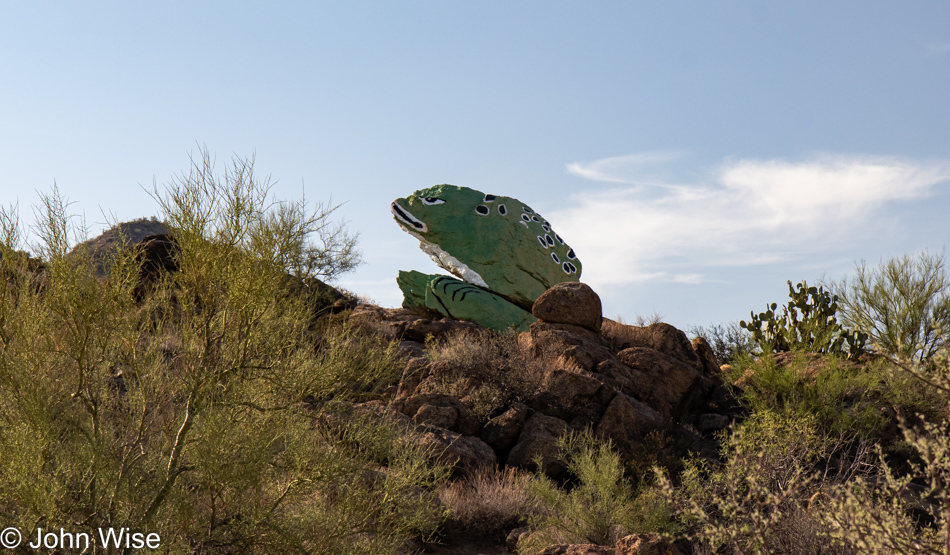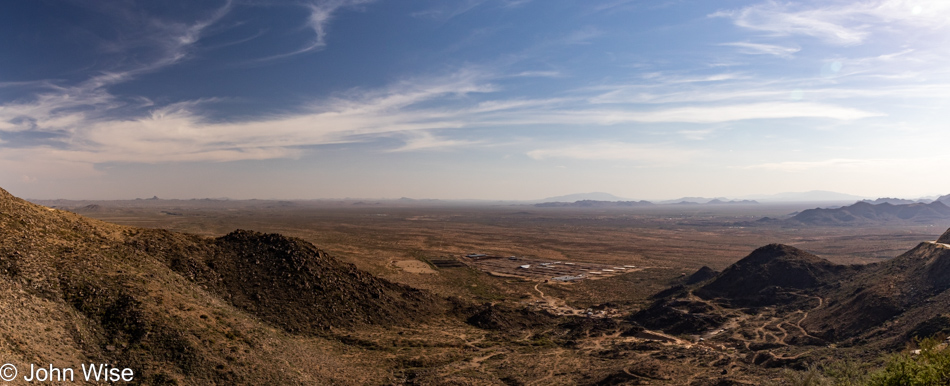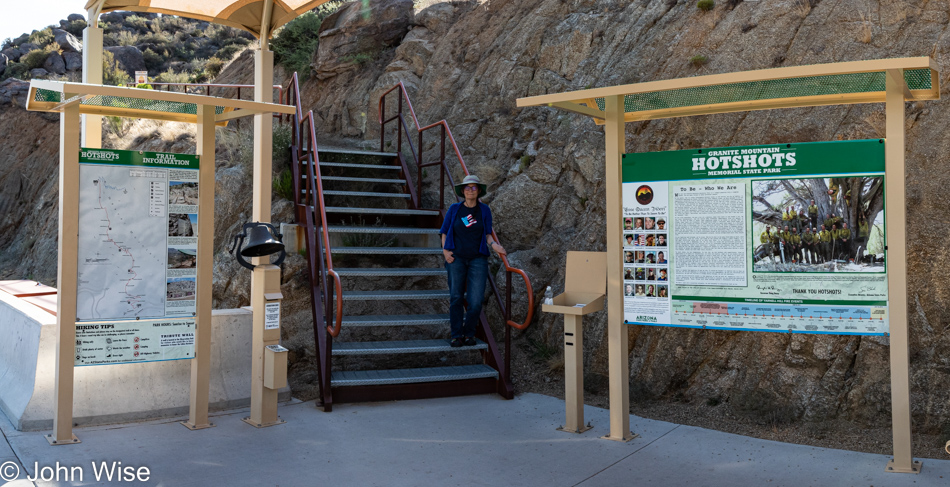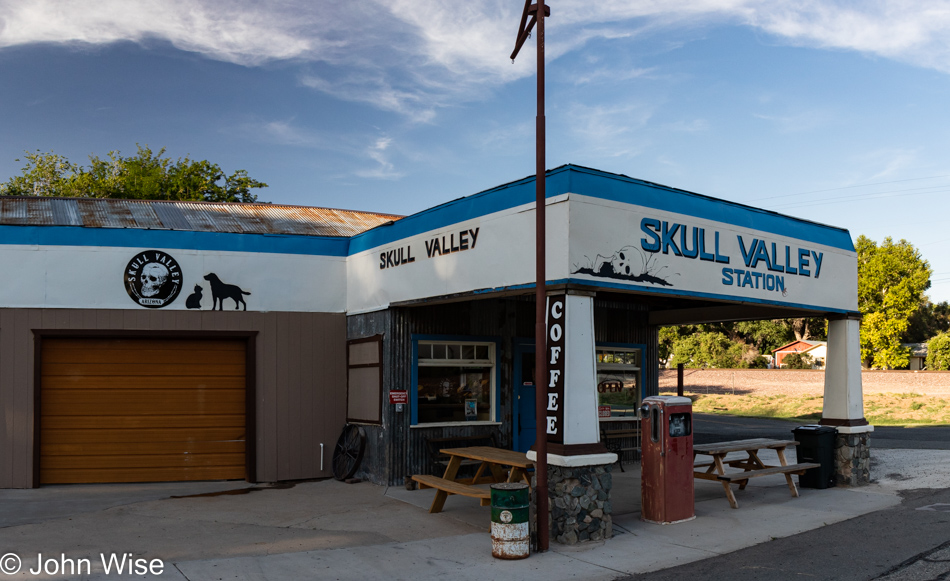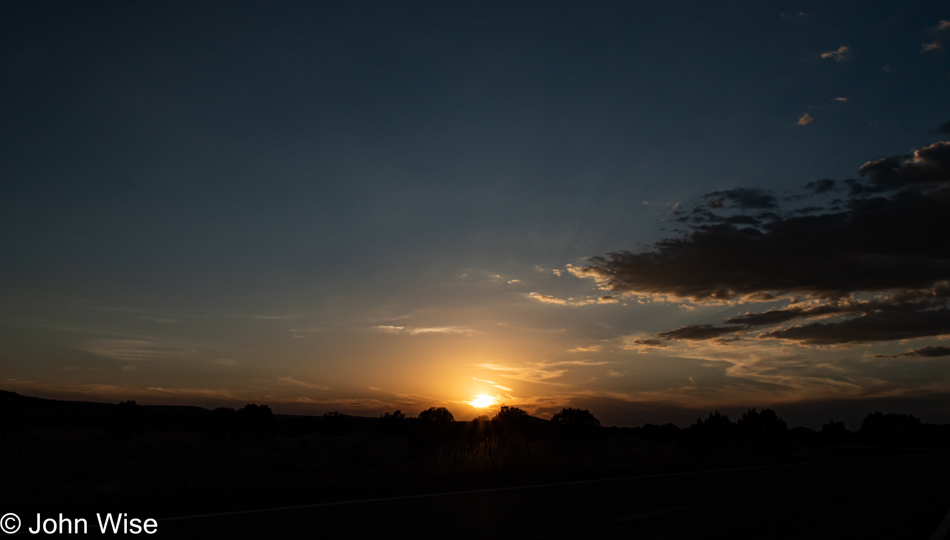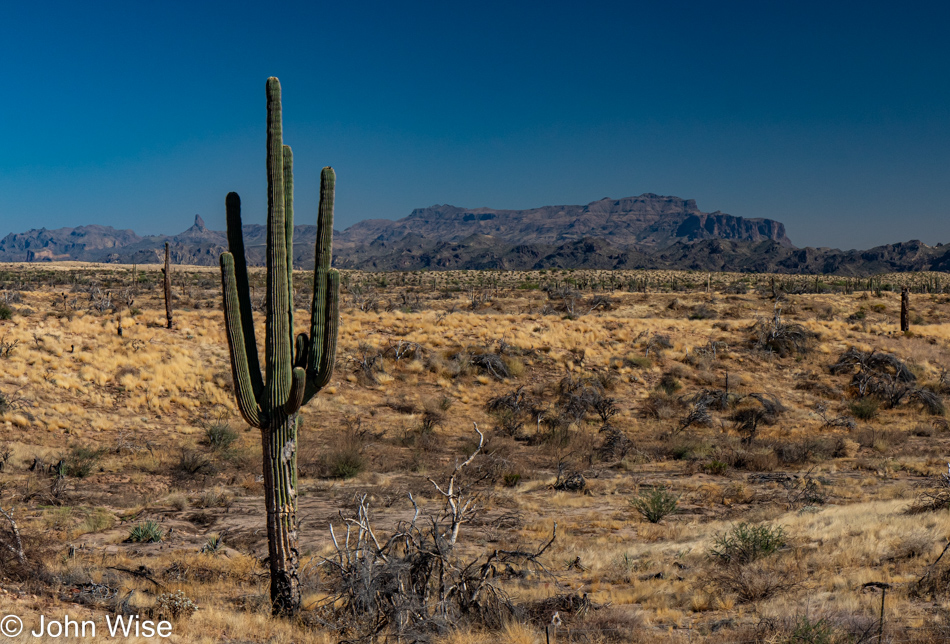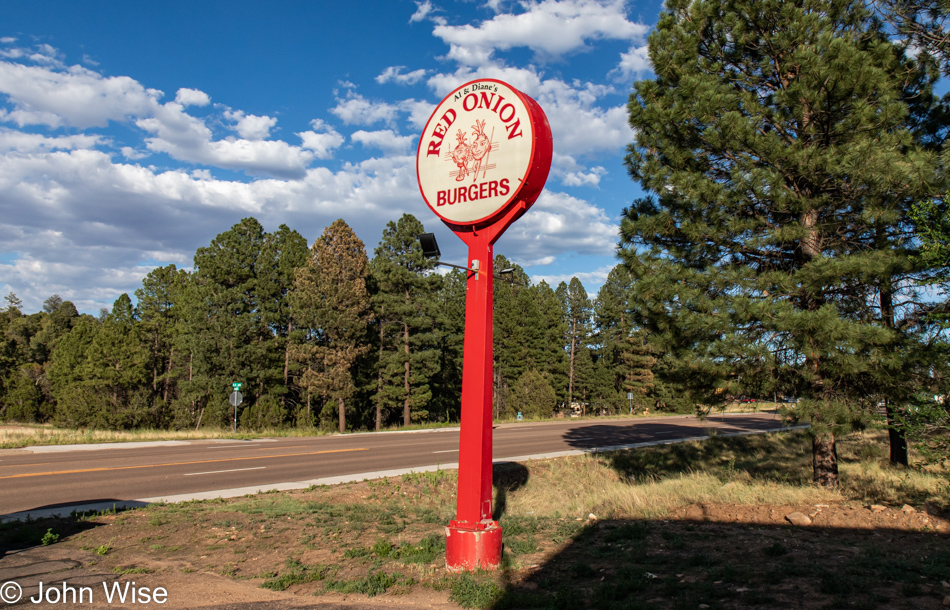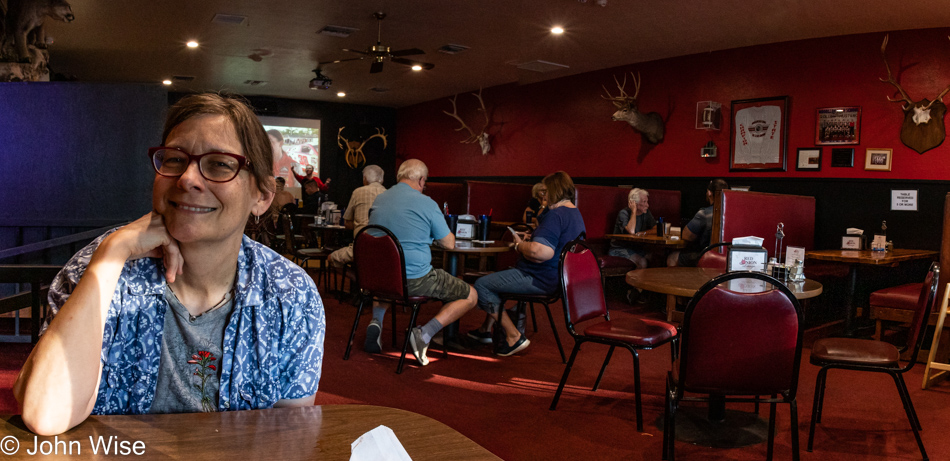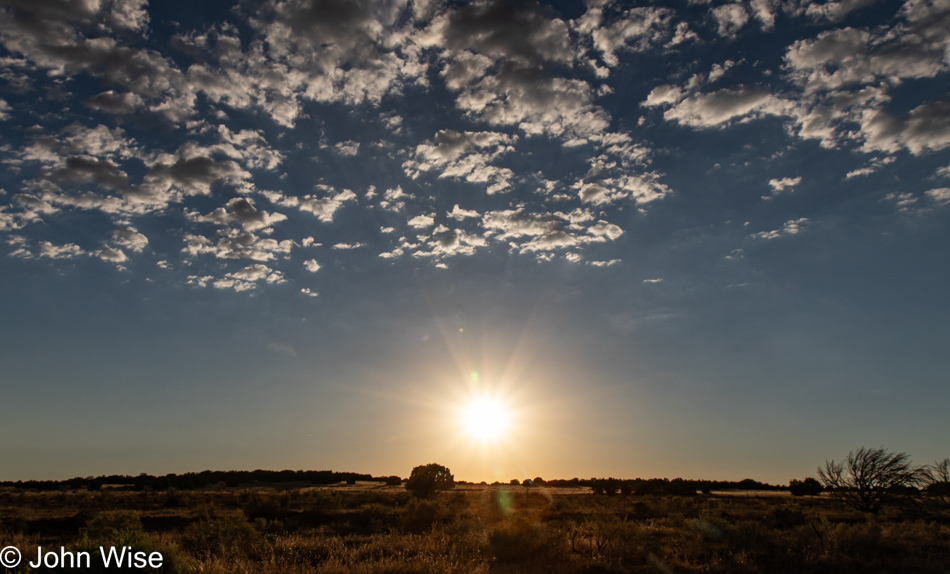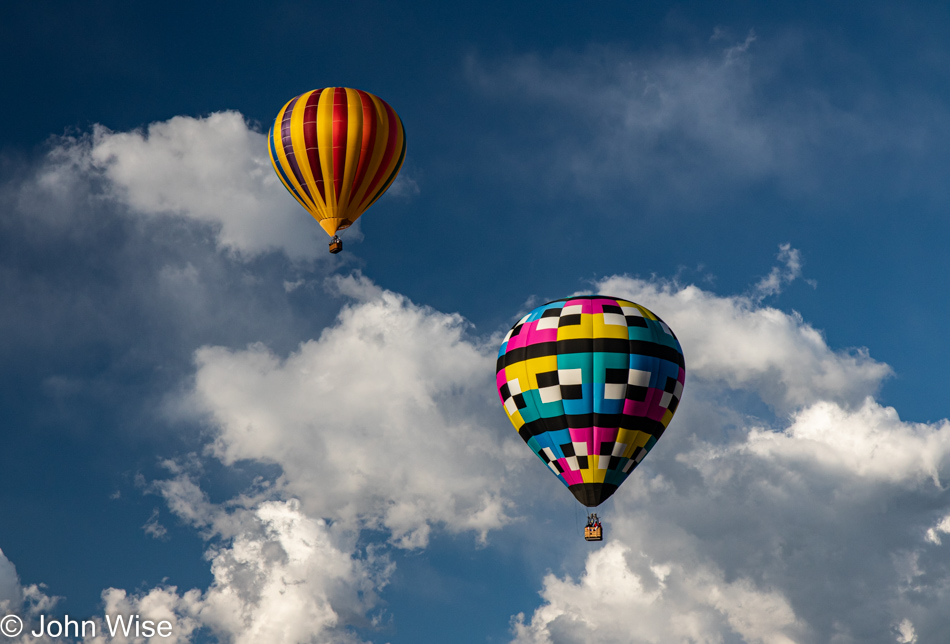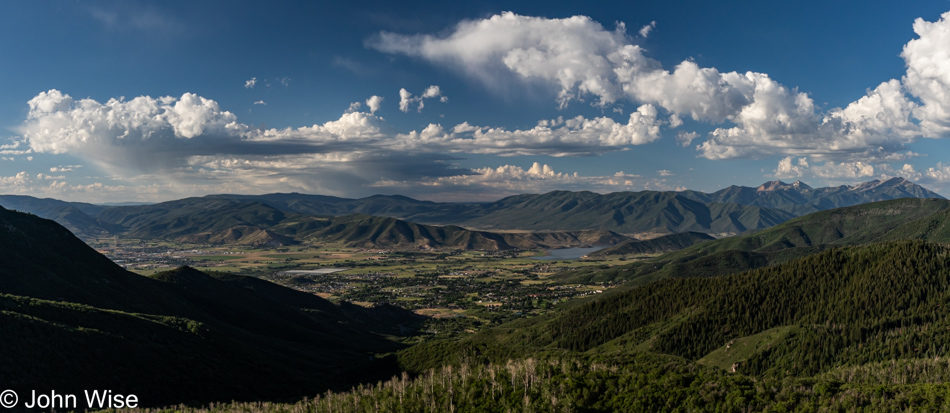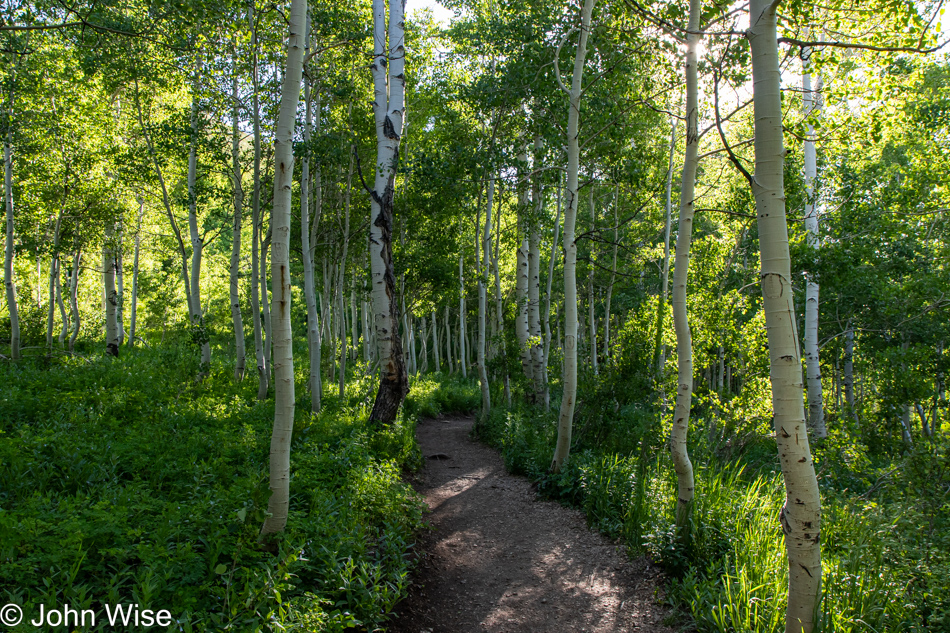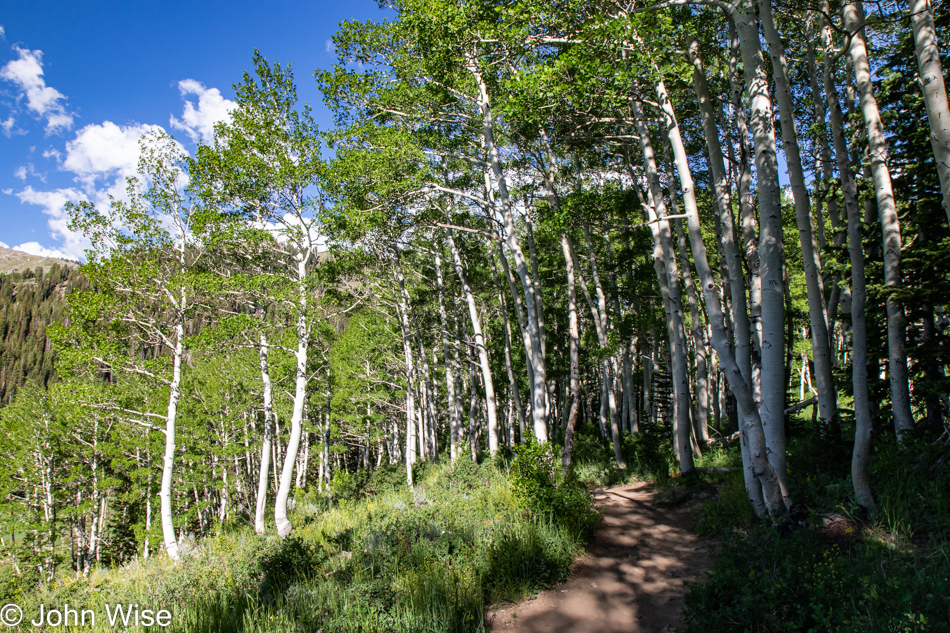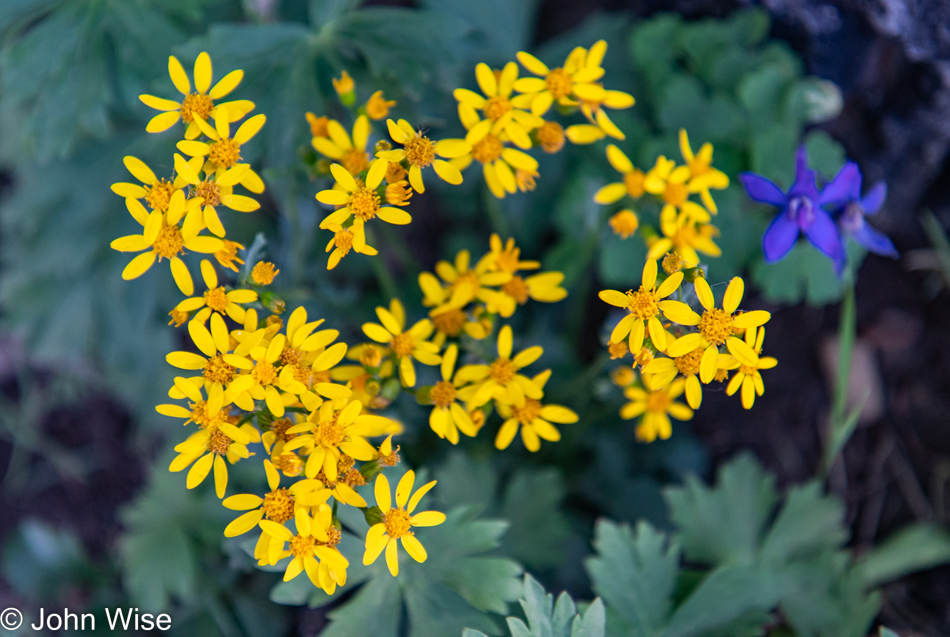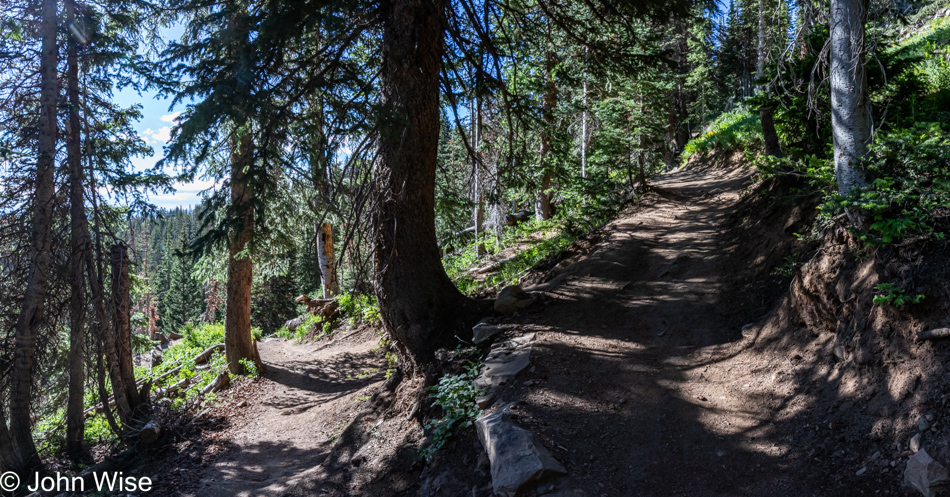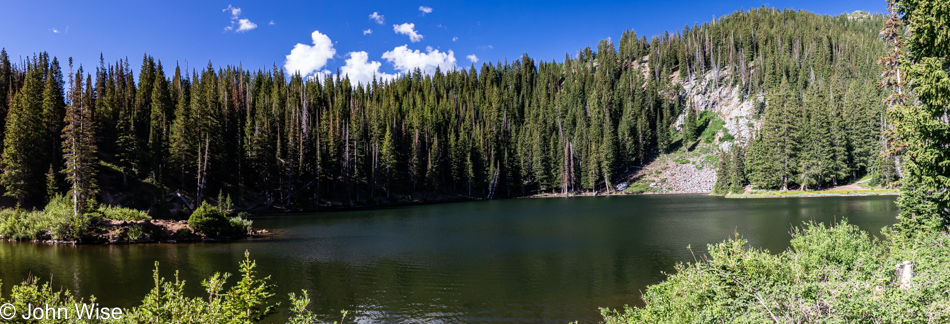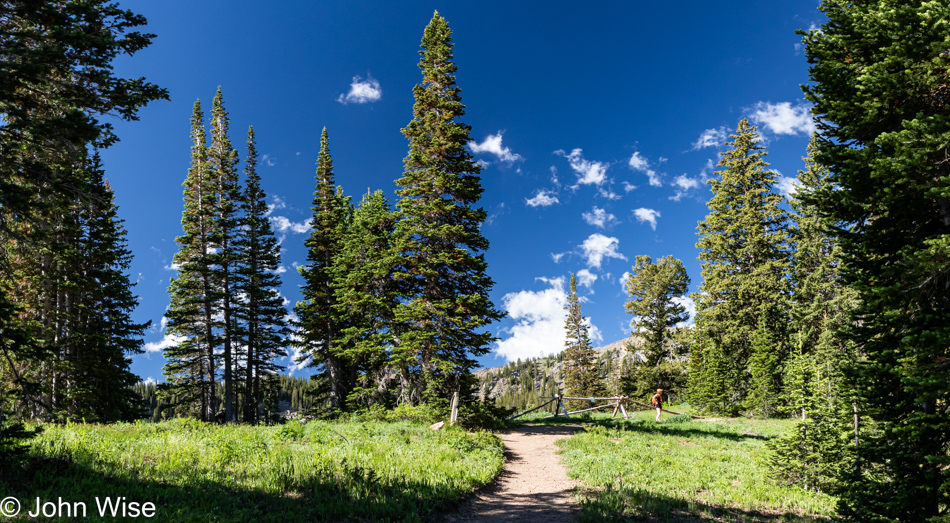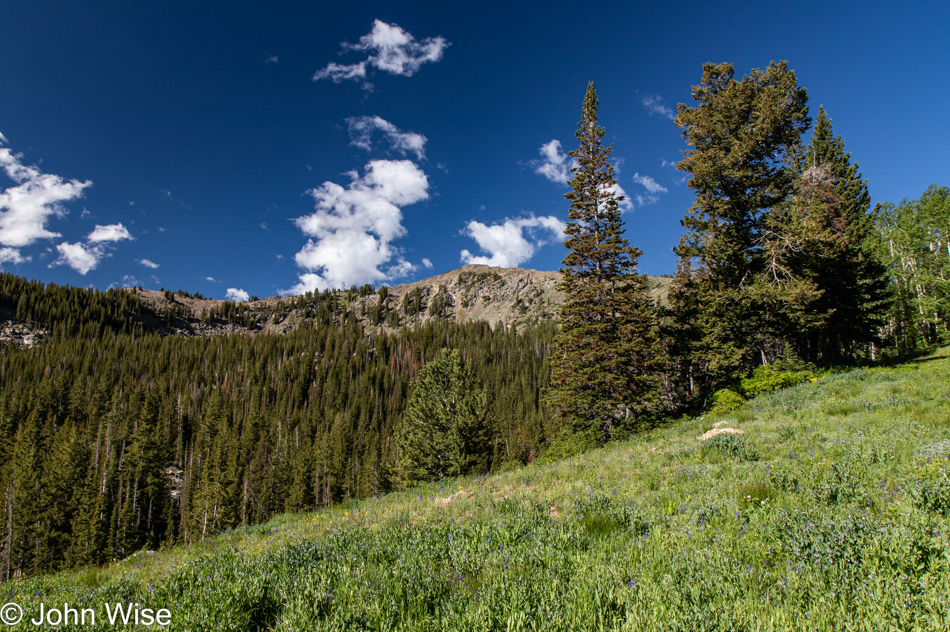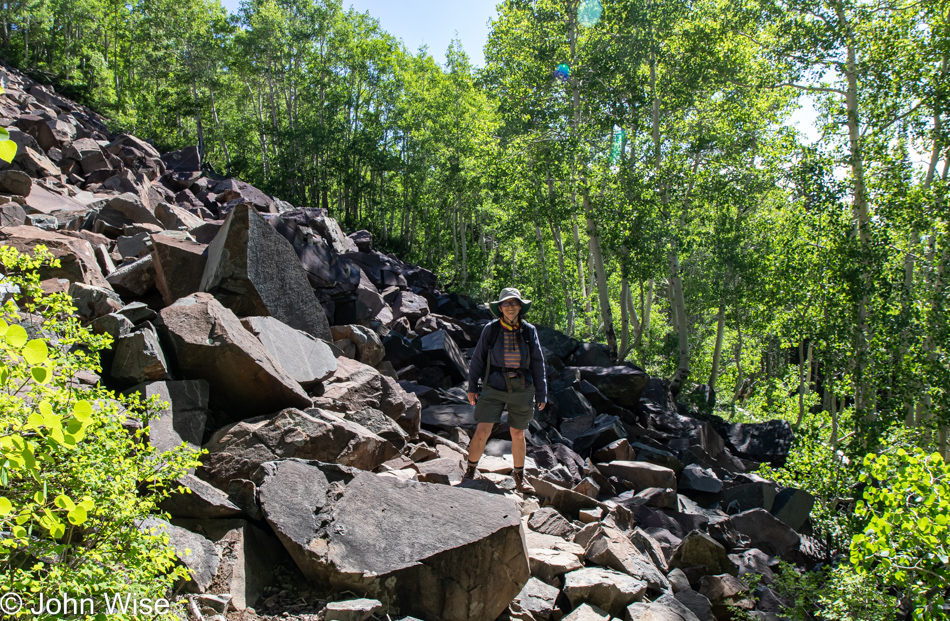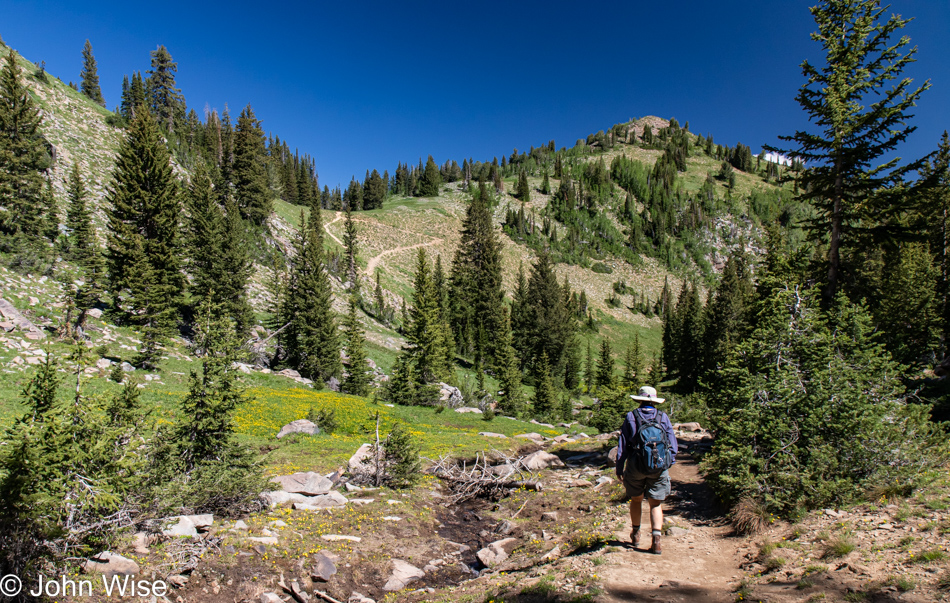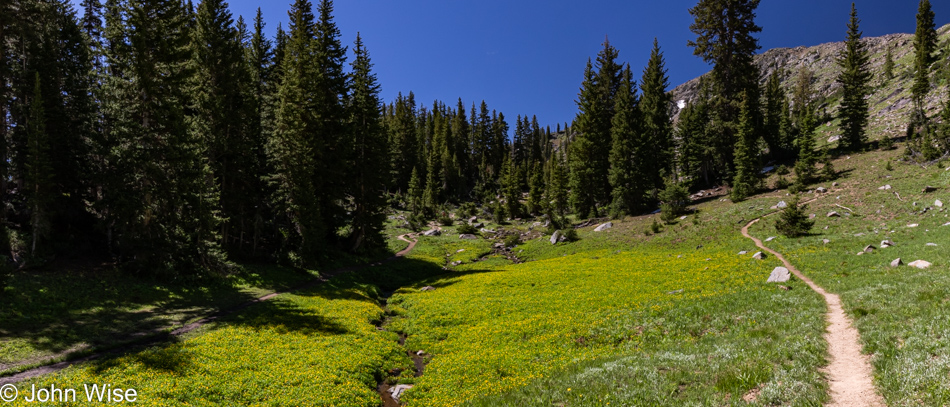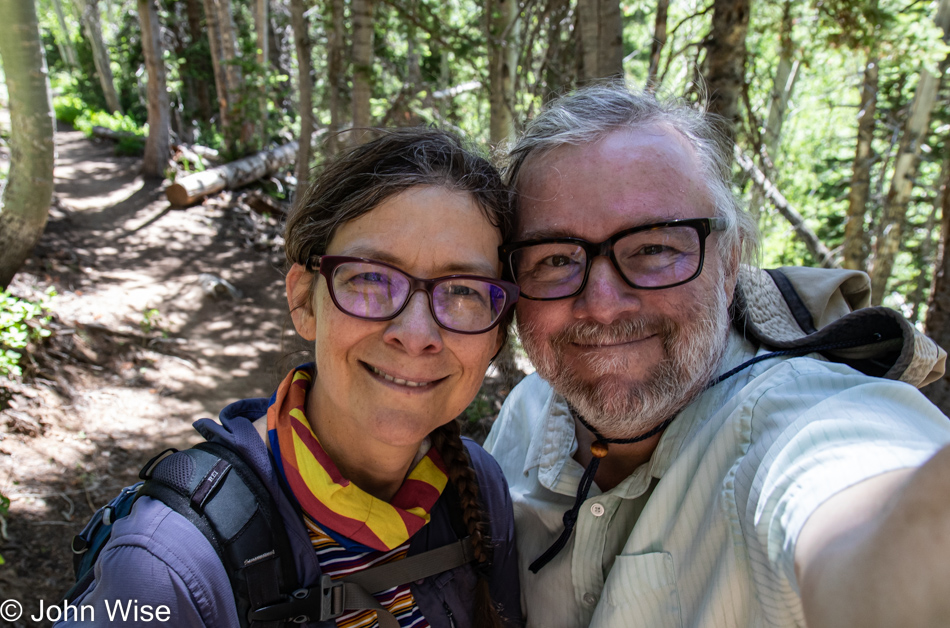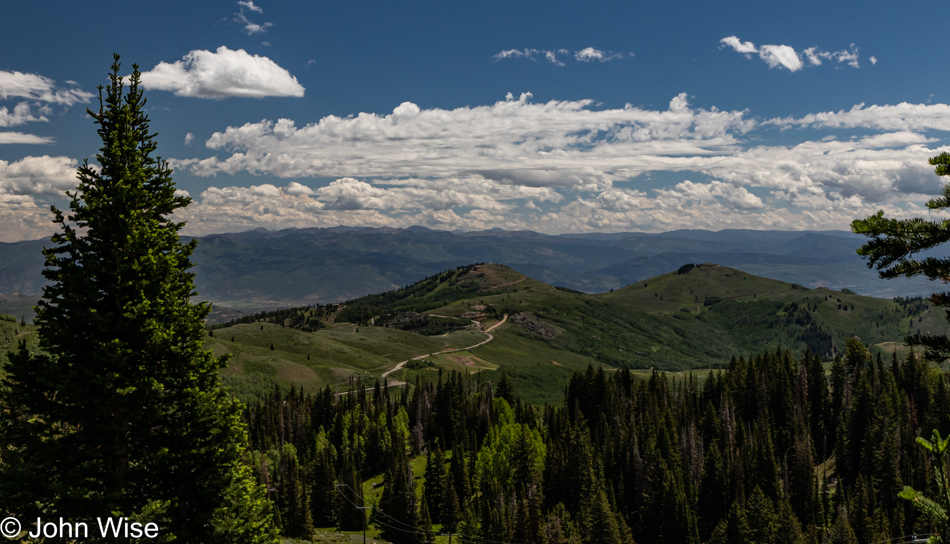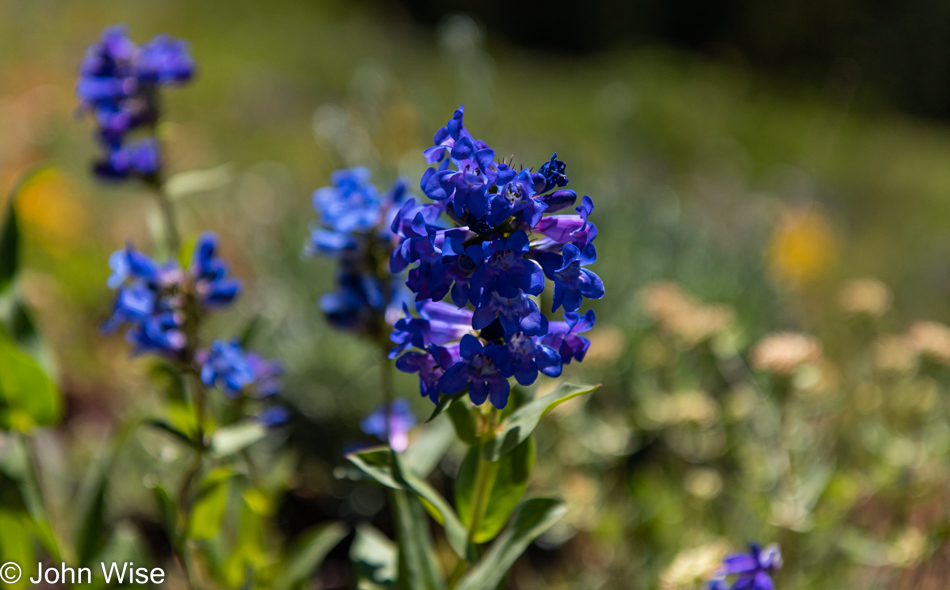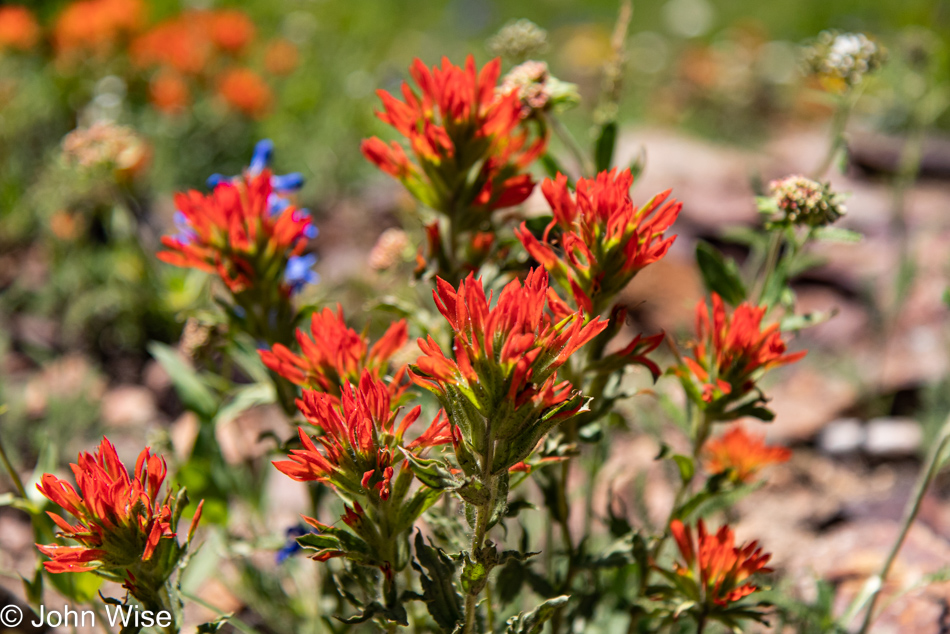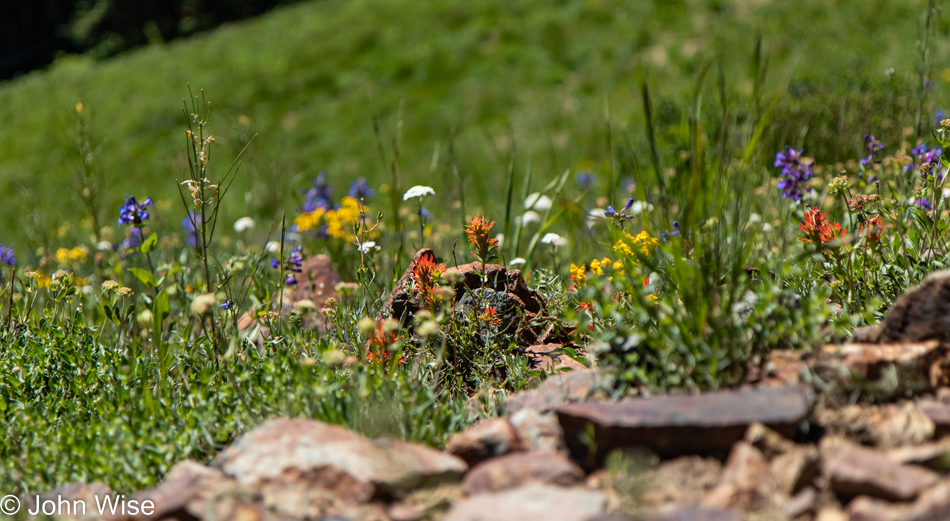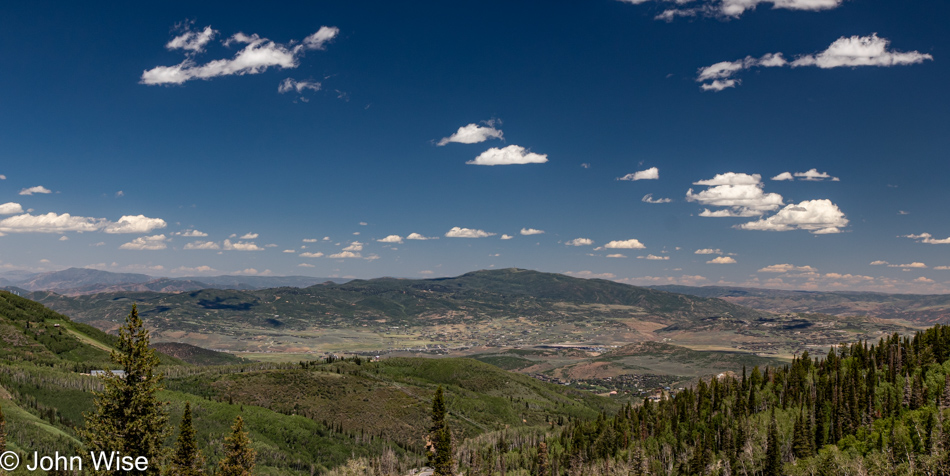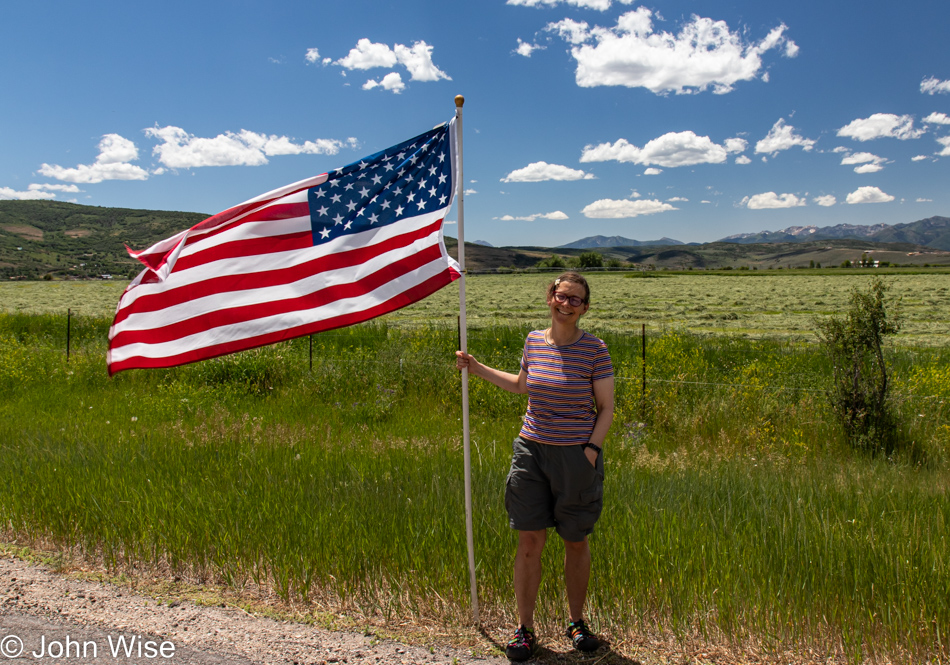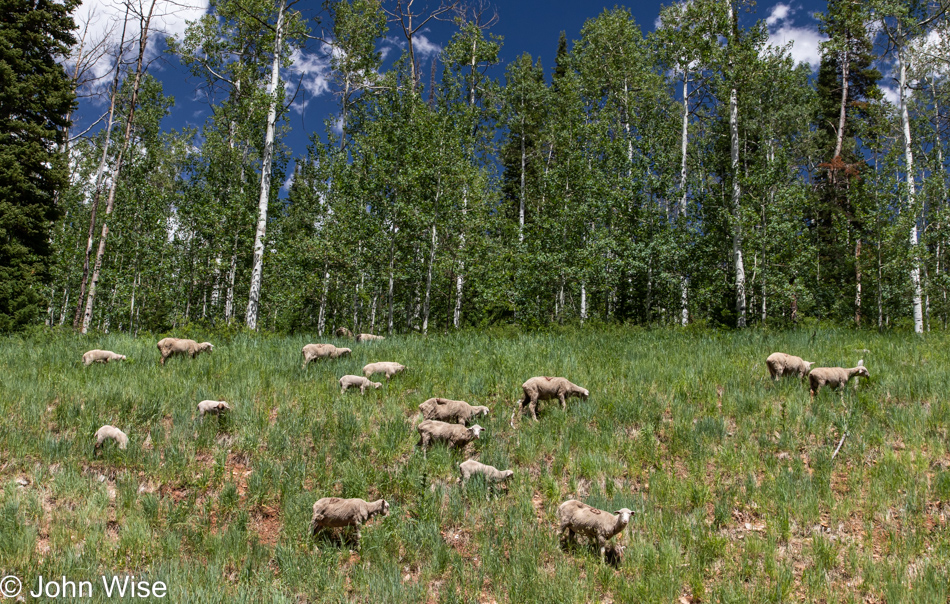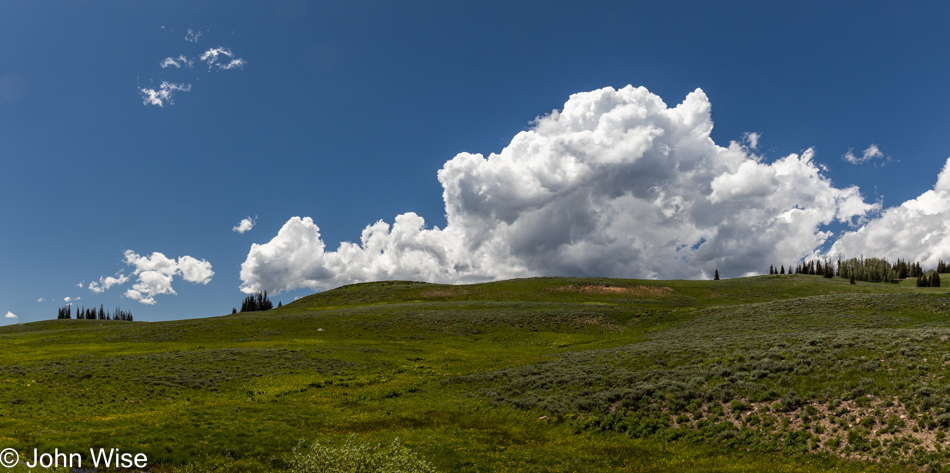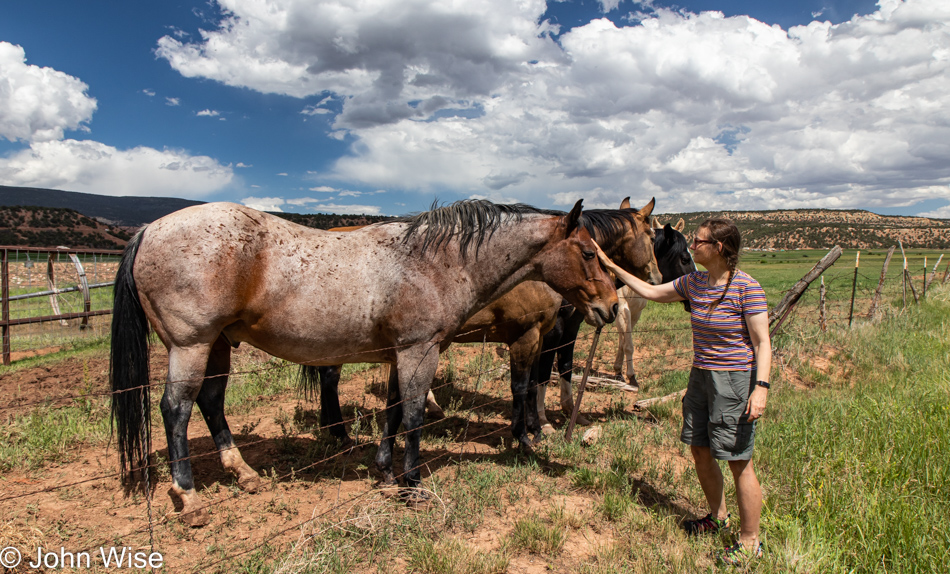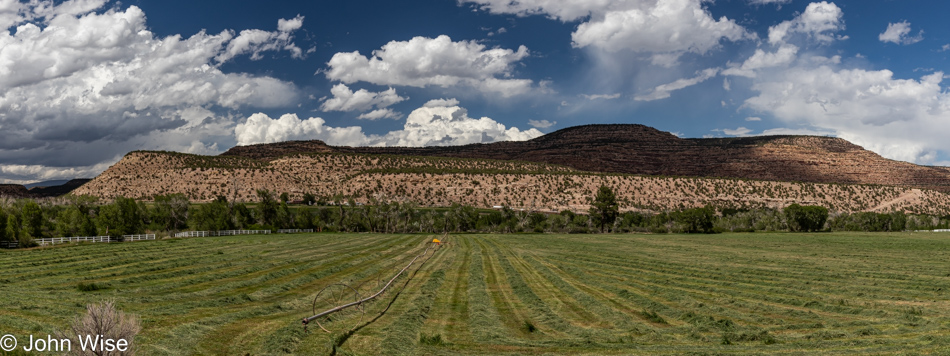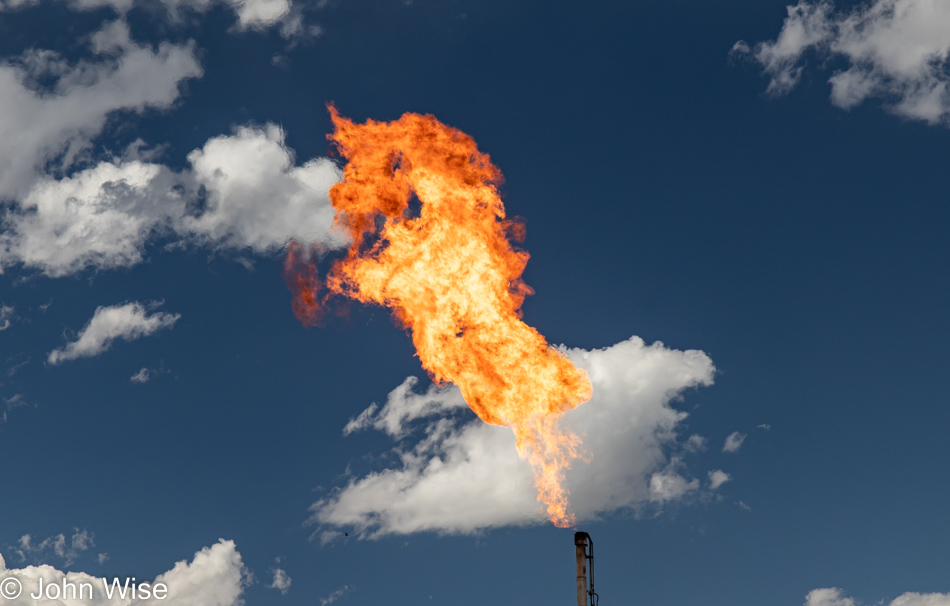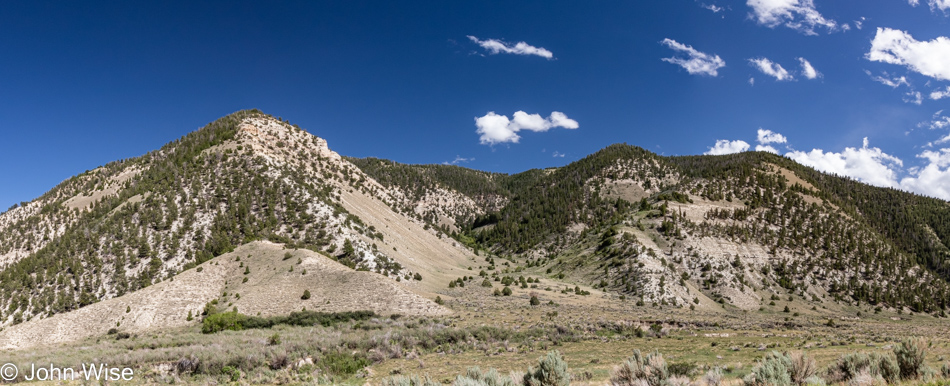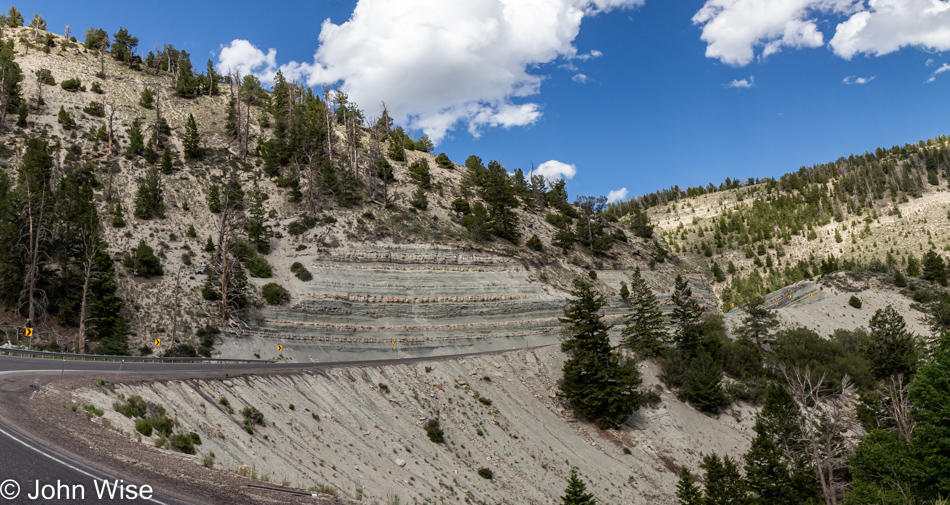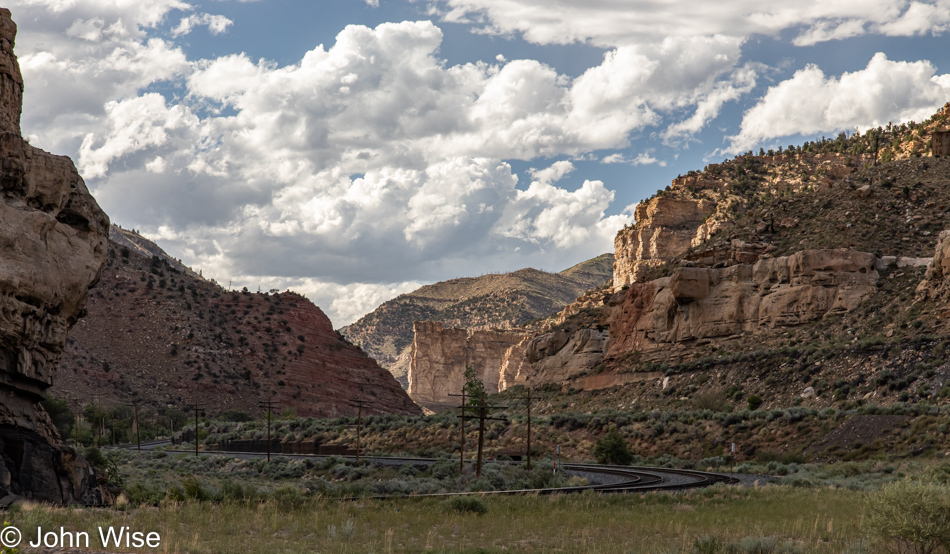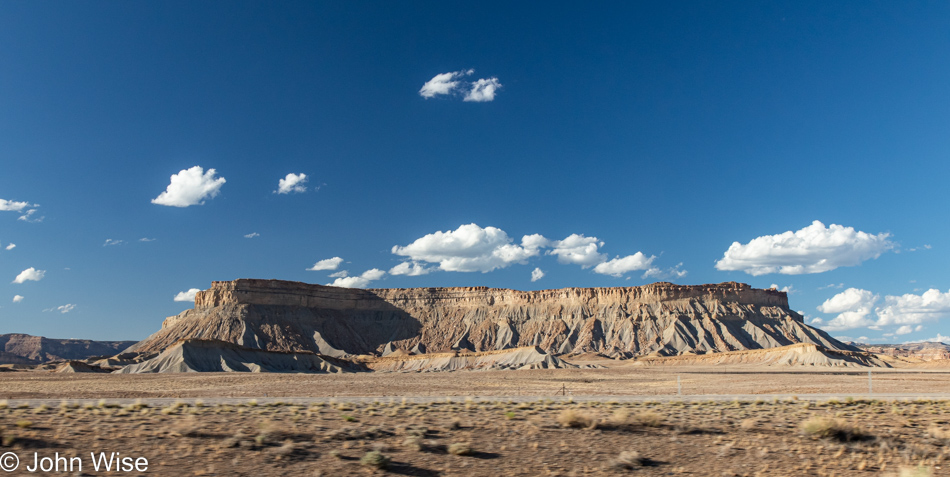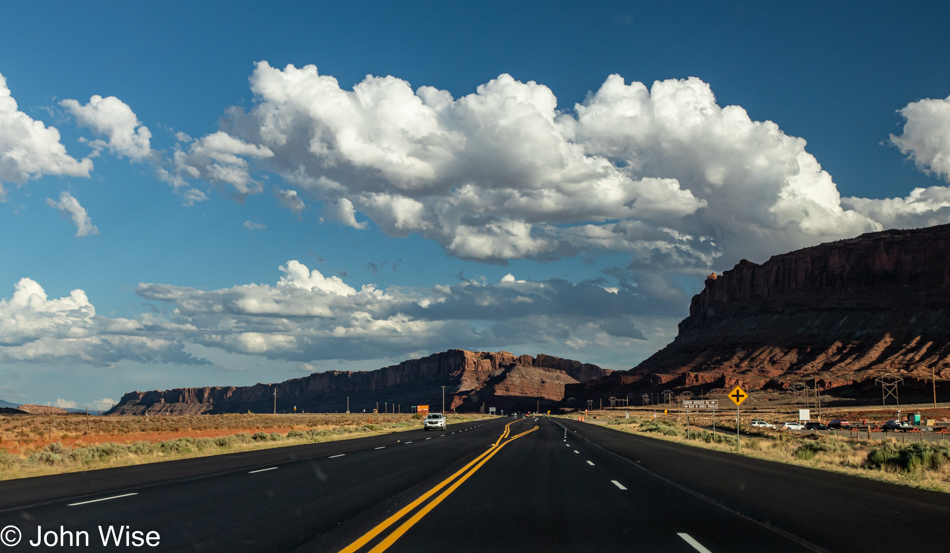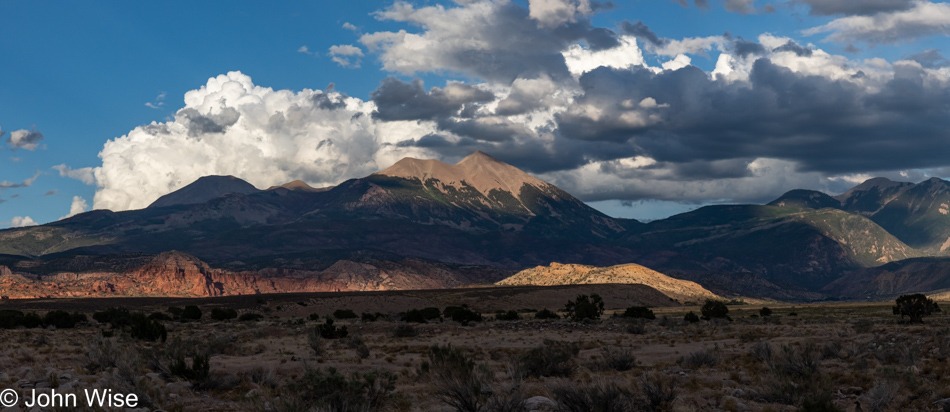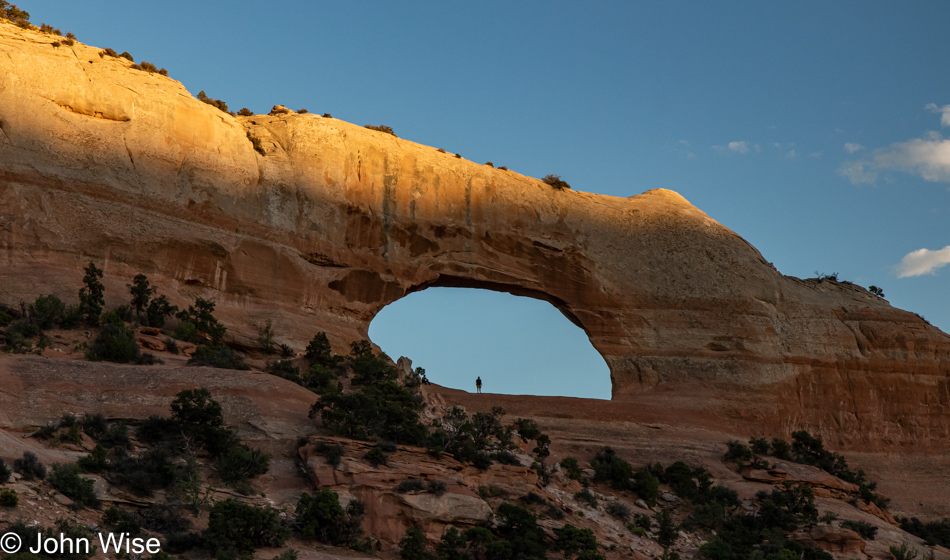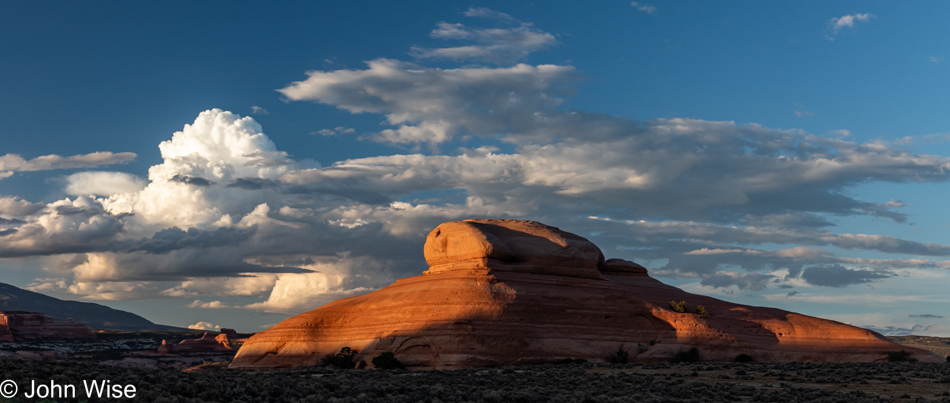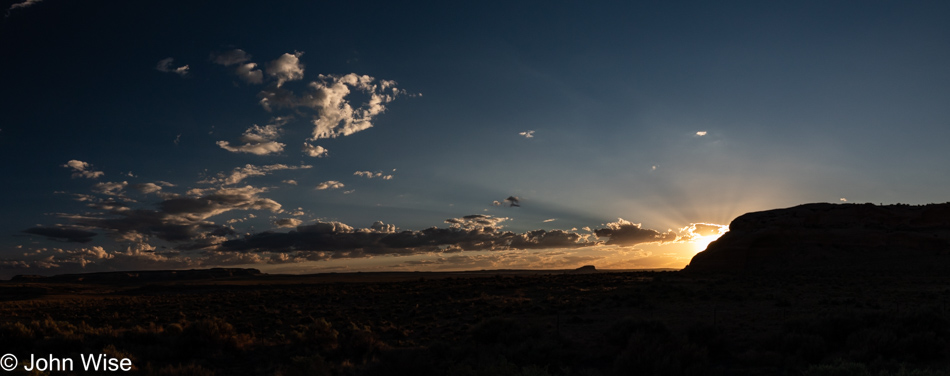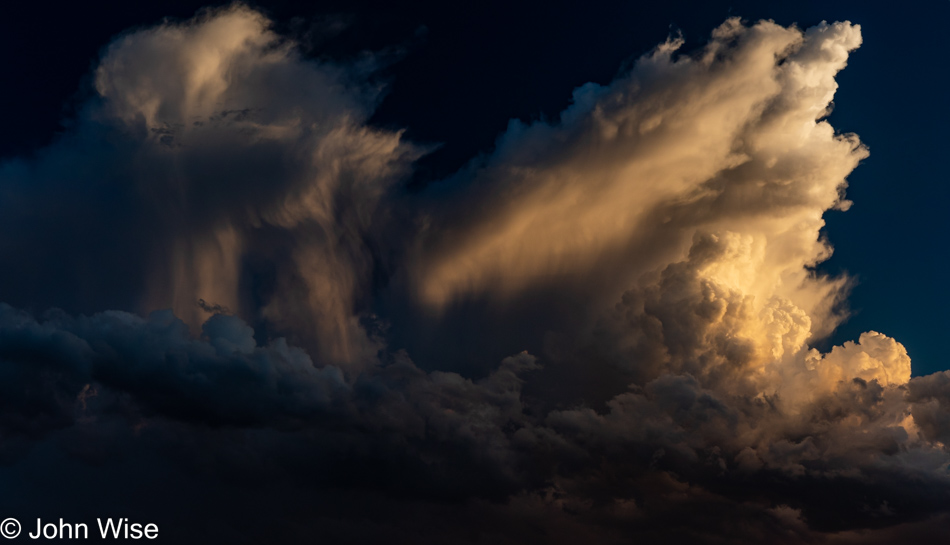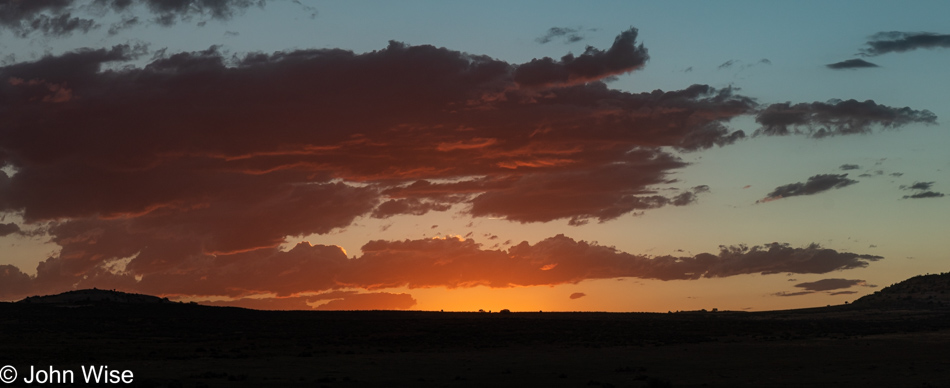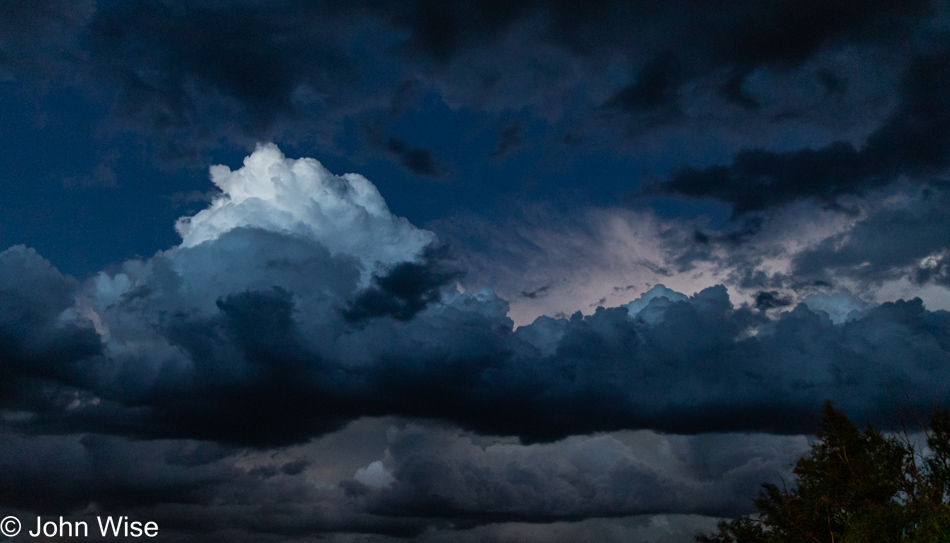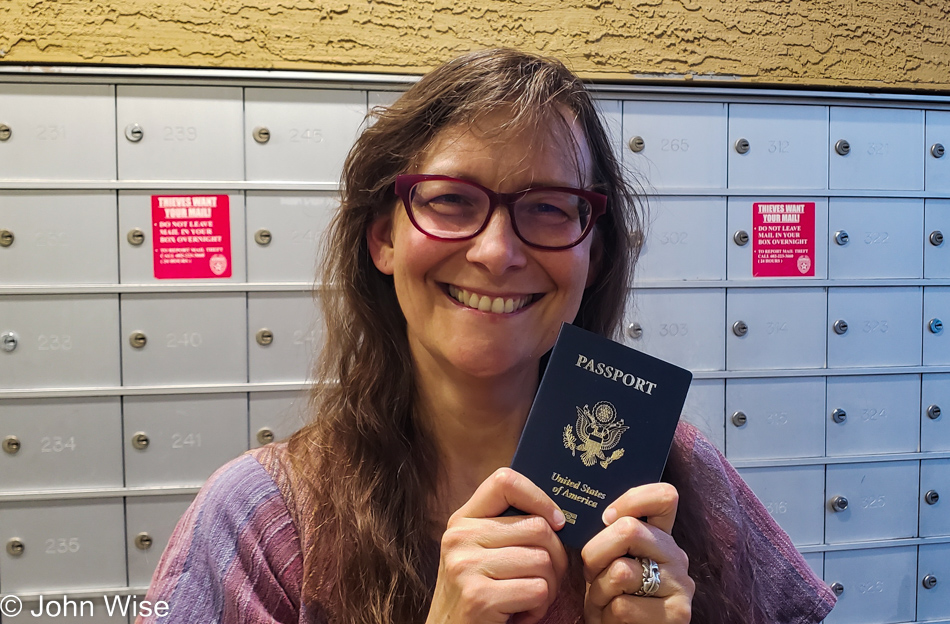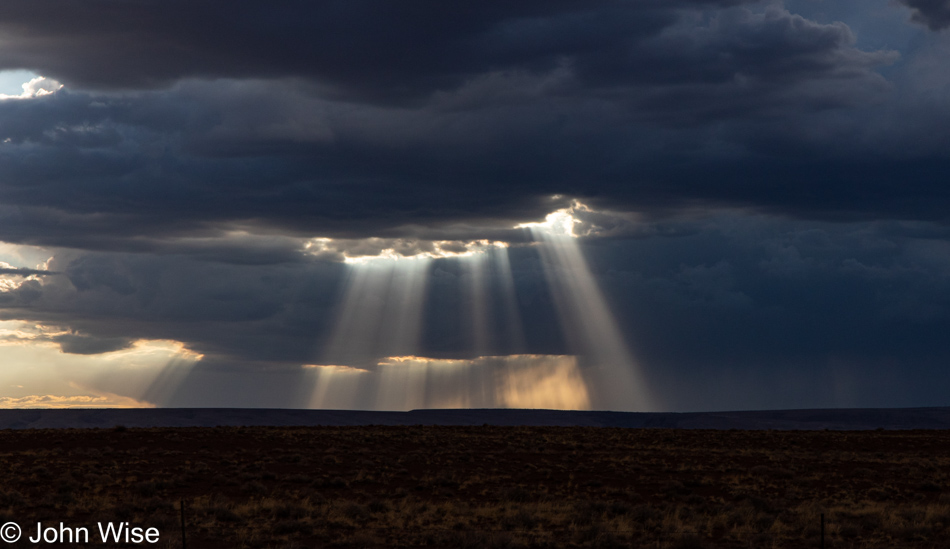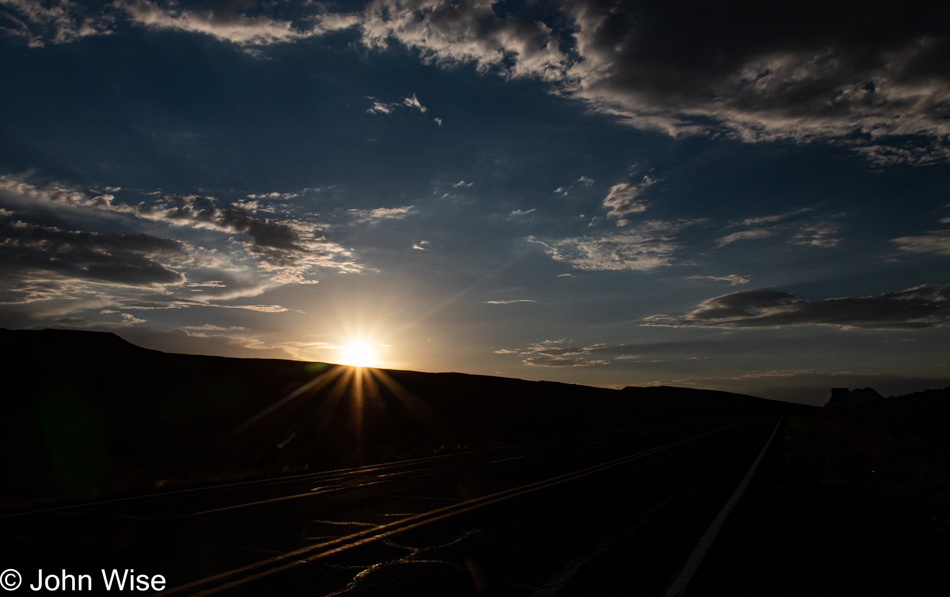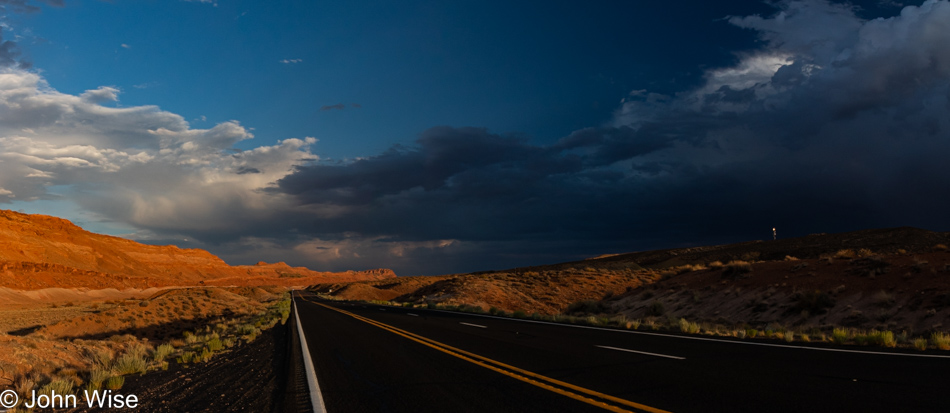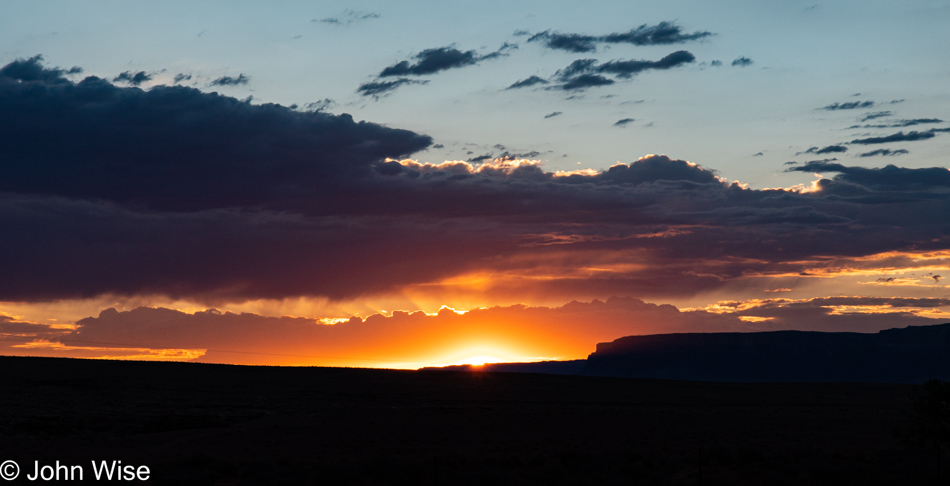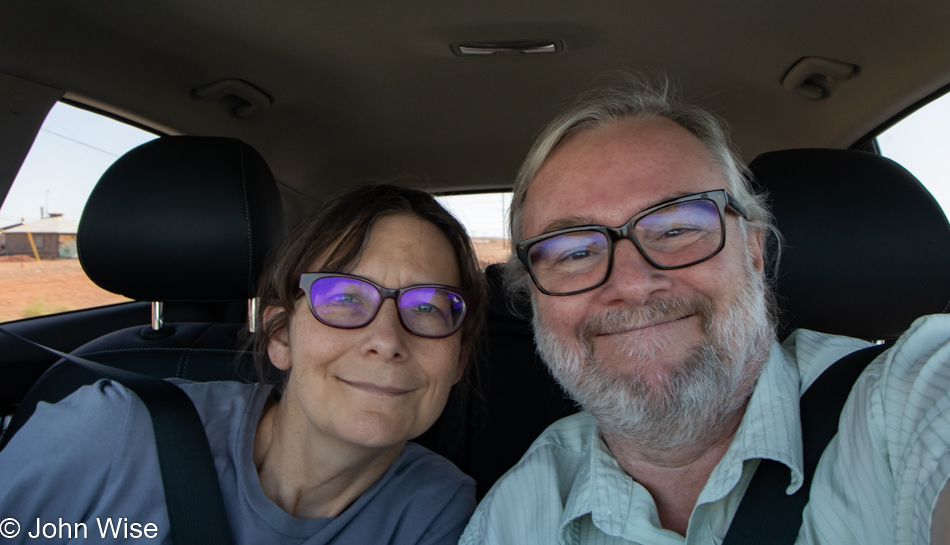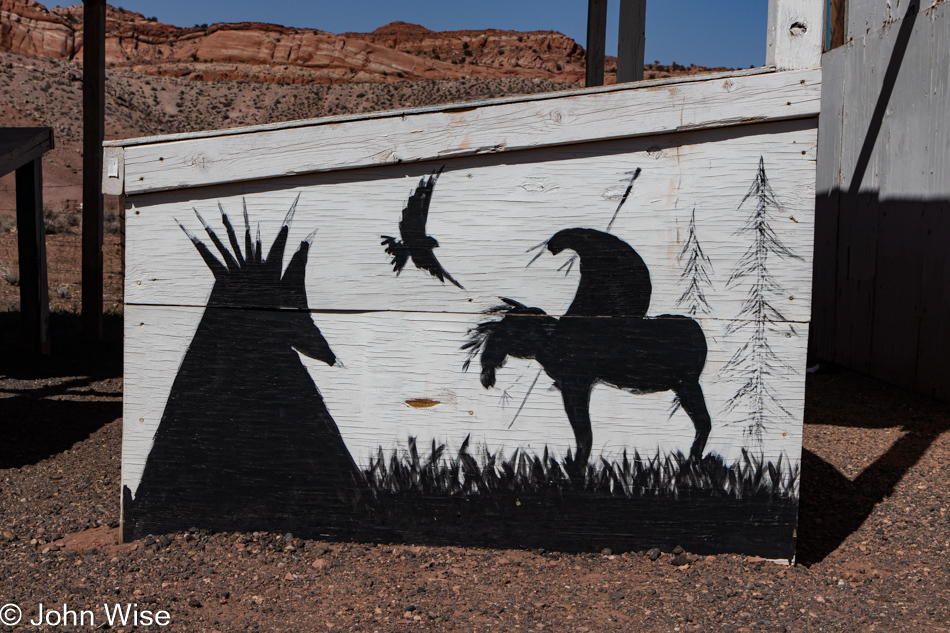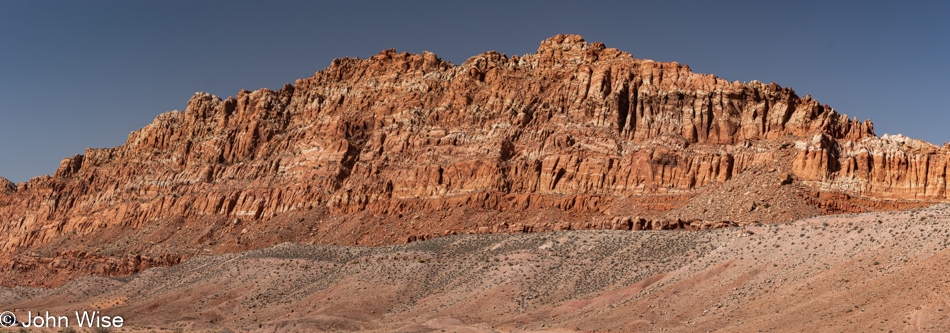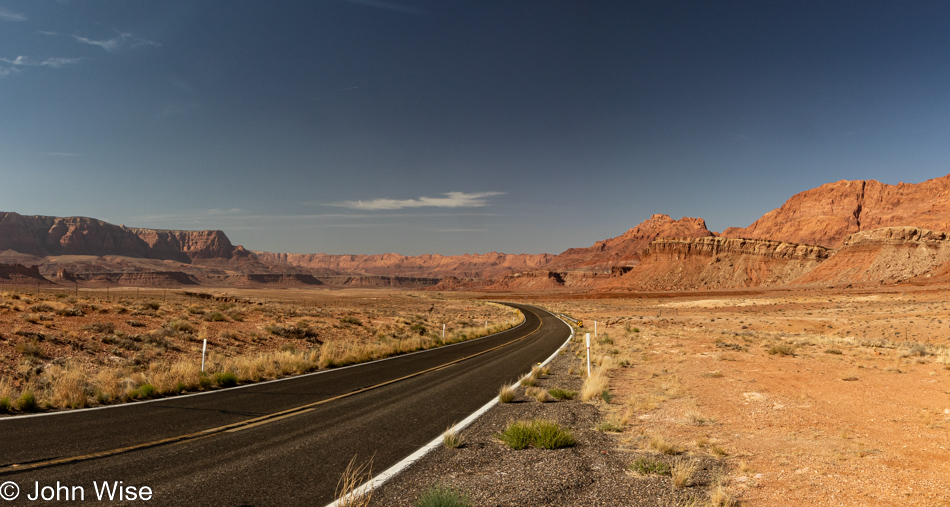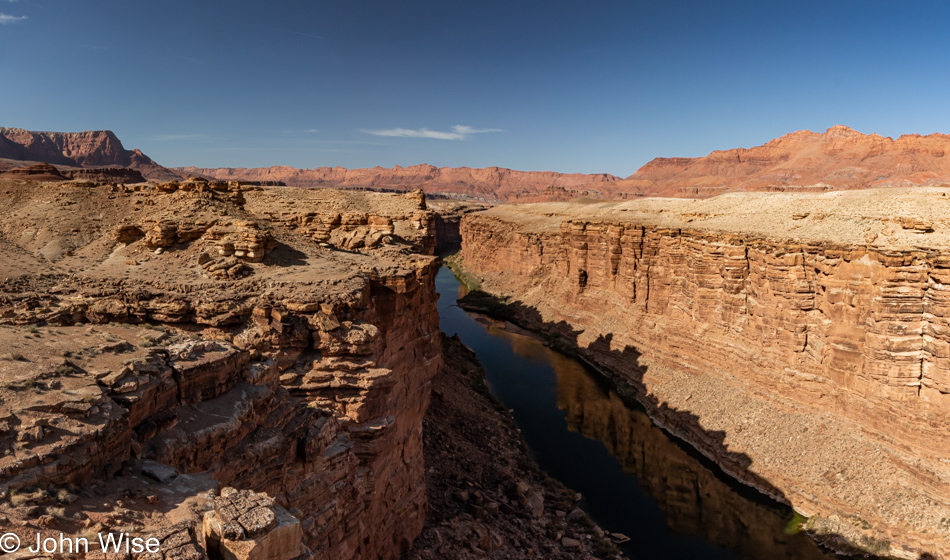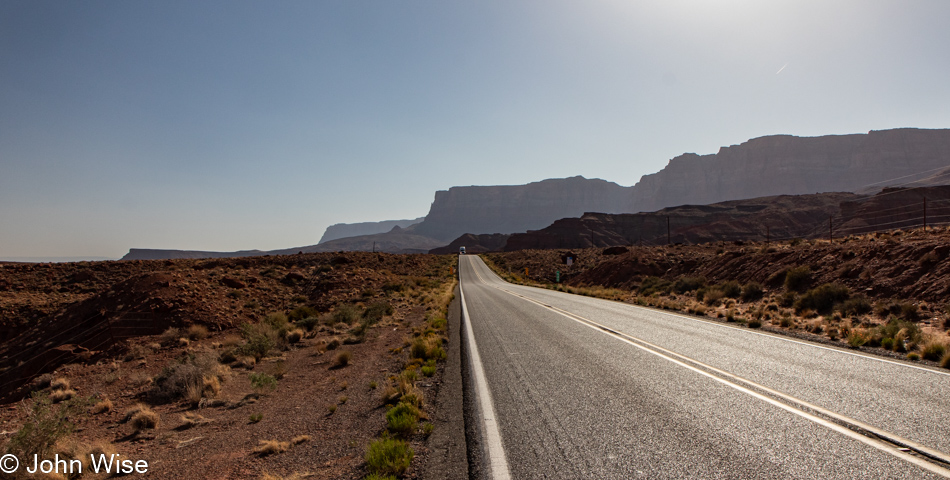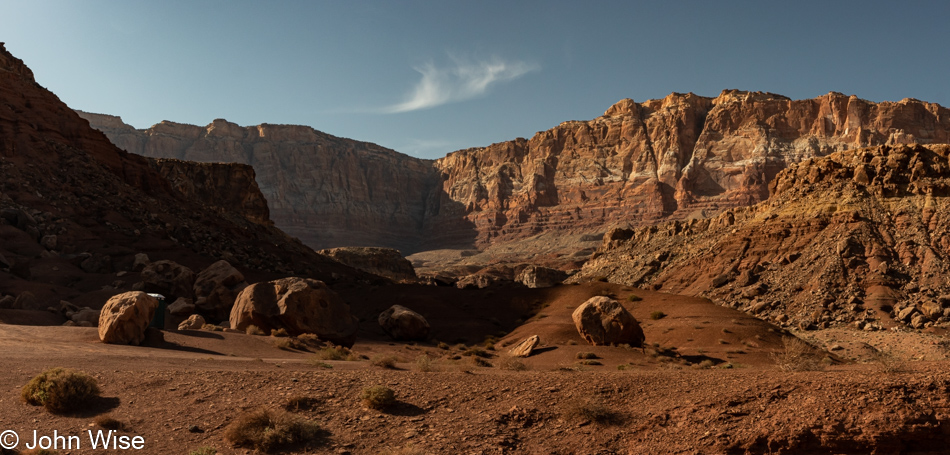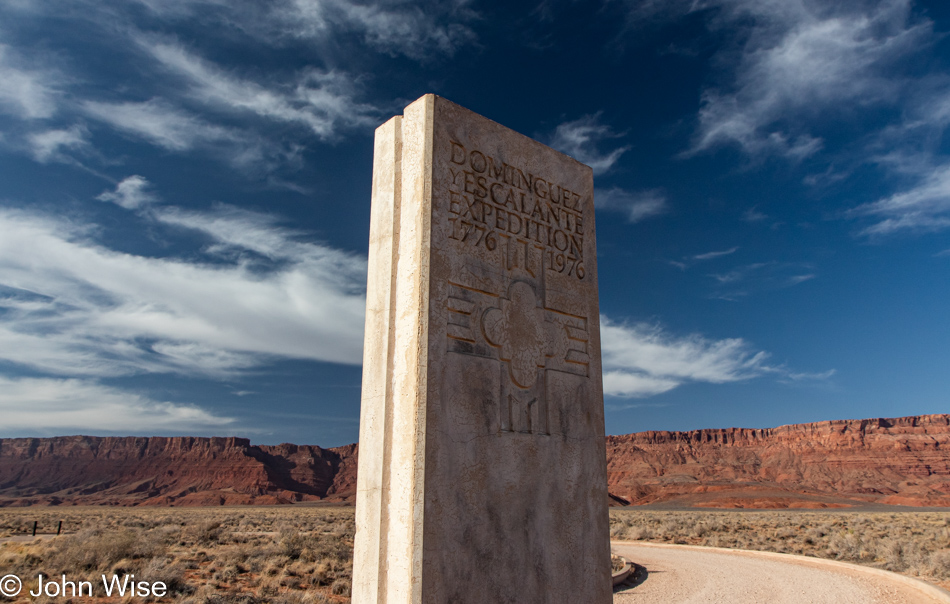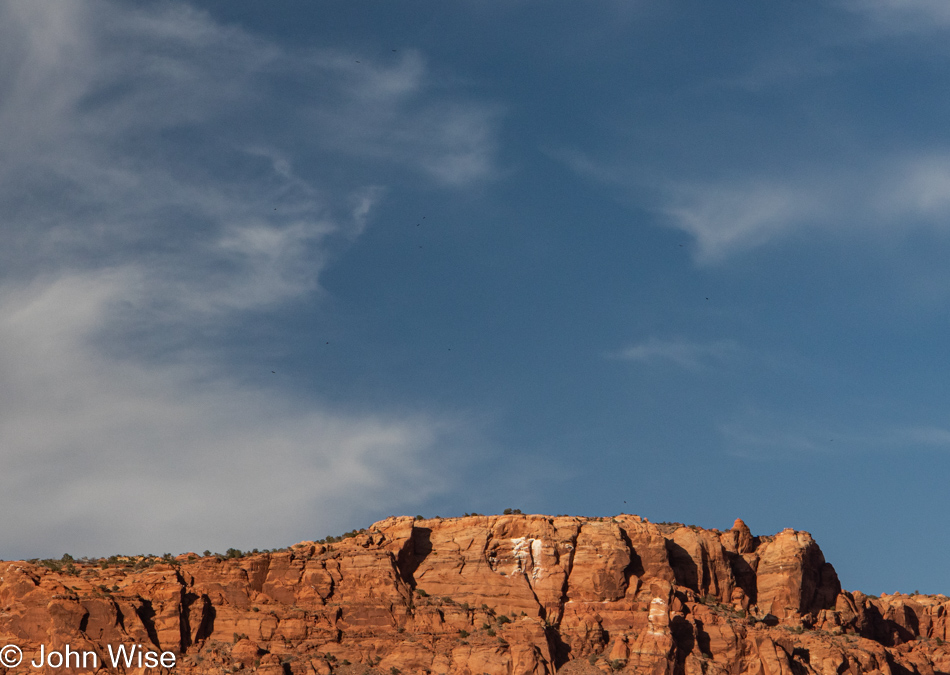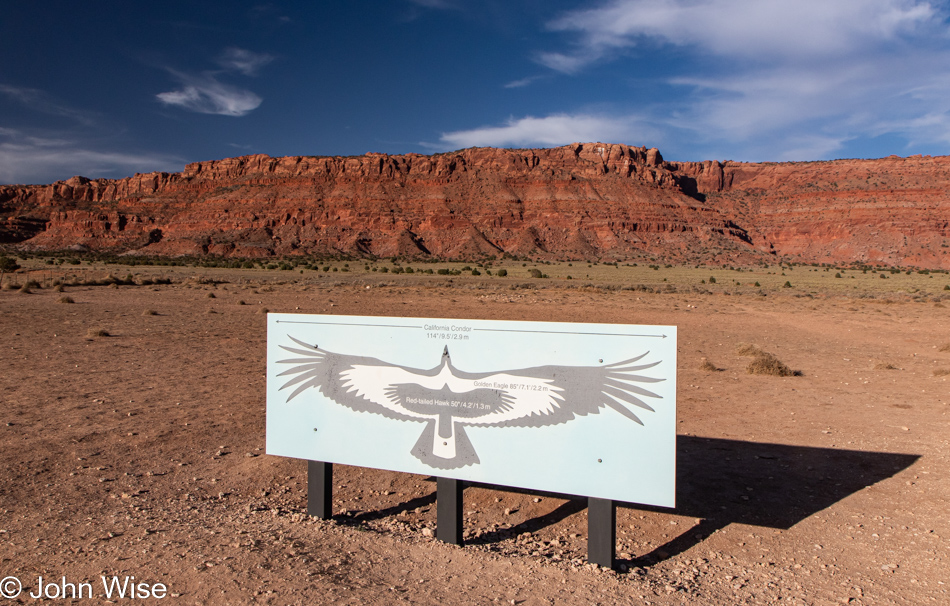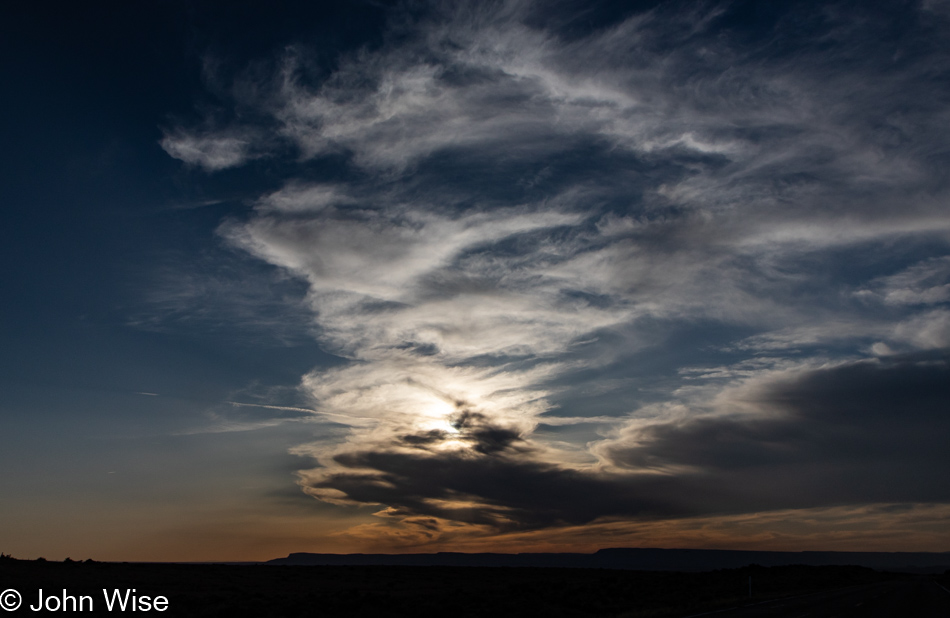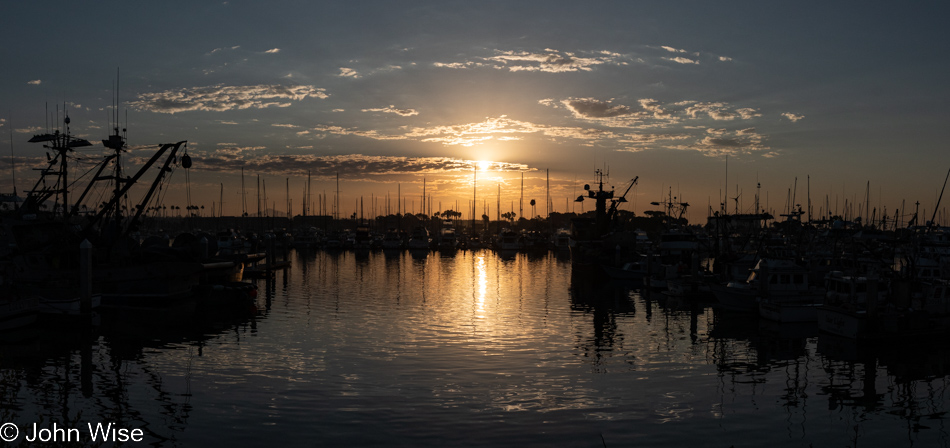
Sunrise over Ventura Harbor and fond memories of a previous visit here that took us out to the Channel Islands with Caroline’s mother, Jutta. Somewhere nearby, we could hear the barking of seals, but we couldn’t find them before turning around for our first walk today by the surf. The light on the shore wasn’t ideal for photos, and we had plenty of other opportunities before the sun sets so we decided to go eat. Breakfast was up the street at a Black Bear Diner, just our speed with all the oldies, meaning the other gray-haired people and the soundtrack playing the hits from the late 50s through the mid-70s. As we were walking out the door, Perry Como started singing It’s Impossible, that’s how old all of us were at this joint. It’s kind of sad that I knew this song until I looked it up and saw that it came out in 1970.
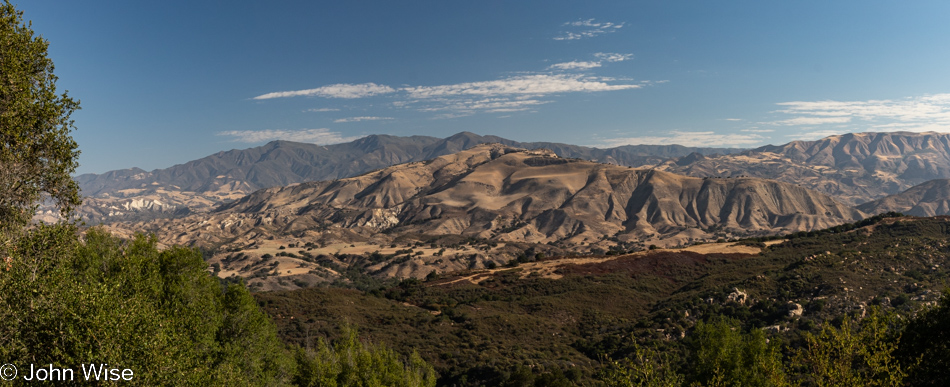
Highway 154 out of Santa Barbara brings us into the Santa Ynez mountain range that we’ve visited many a time by now. On more than one occasion, we found ourselves up here at the historic Cold Springs Tavern for breakfast with different family members, including aunts and uncles, my daughter, and my mother-in-law. I took this photo at the Goleta San Marcos Road Vista Point.
We keep the windows open driving north, and the cool ocean air drifts in as the temperature fluctuates from the low 60s and, from time to time, hits nearly 80. Here on the inland segment of today’s drive, we are listening to Royksopp (Norwegian thing), Luna (Ukrainian thing), Mine (German thing), and a bit of Ethel Cain (Floridian thing) as vineyards dot a landscape between golden brown rolling hills. The smell of a skunk or two deeply penetrates the car, requiring windows to be opened wider. On the sad news front, the first potential yarn store in San Luis Obispo doesn’t open until 11:00, so we’ll have to skip that stop.
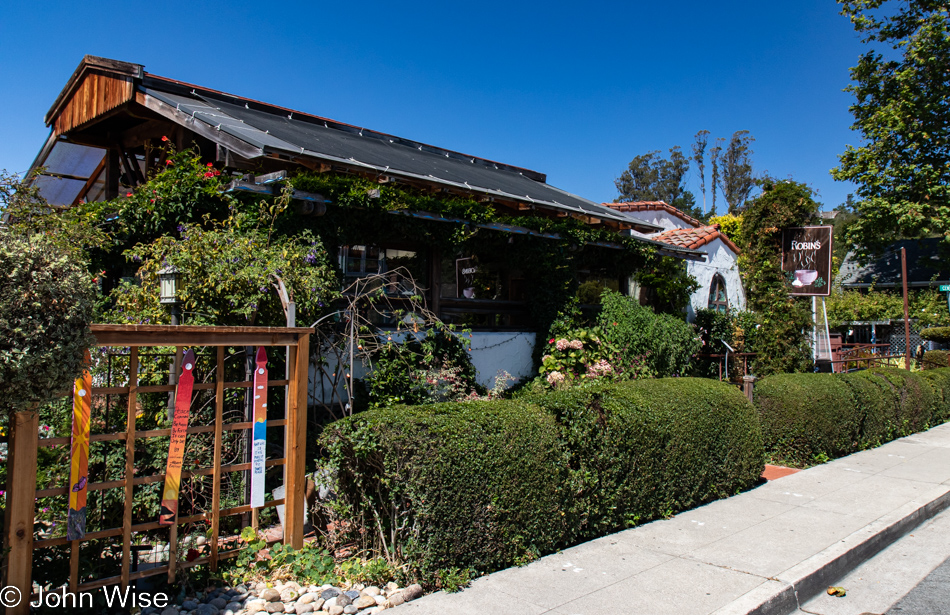
On the approach to Cambria, where we’ll be staying in a couple of days, Caroline suggests we stop for an early lunch. I considered Lucia’s just 48 miles up the road, but if we drive slow, and we will, it could be nearly dinner time by the time we reach that spot on the coast, so Cambria it is. We’ve been here before, which can almost be said about everything we’ll be visiting today; here is Robin’s Restaurant. It was just last year, on May 1st, that we first sat down on their lovely garden patio to have lunch on our way to Pacific Grove, making today look like a replay of last year’s coastal adventure.
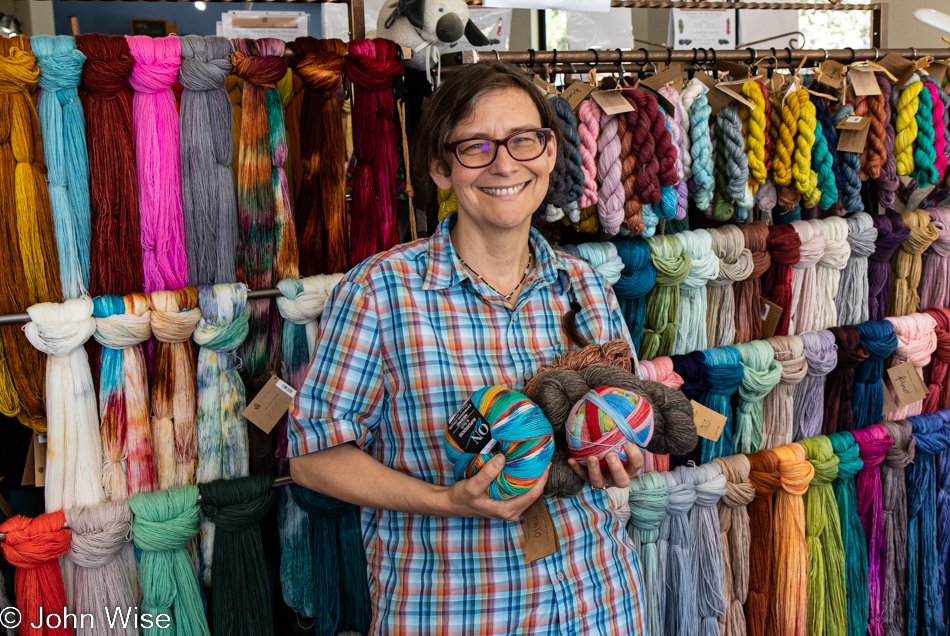
Not wanting to risk that the Ball & Skein Yarn Store would be closed on Sunday or Labor Day Monday, we were going to have to yarn shop our guts out right here, right now. Caroline is only allowed to buy what she can carry, and while she could have easily carried more, her knowledge that she has precious little space at home to store more had her considering just how much she should walk out with. Hmm, thinking about this last bit I just wrote, I can’t risk my wife outing me, so the truth is that the two colorful skeins are destined to become socks for me and were of my choosing.
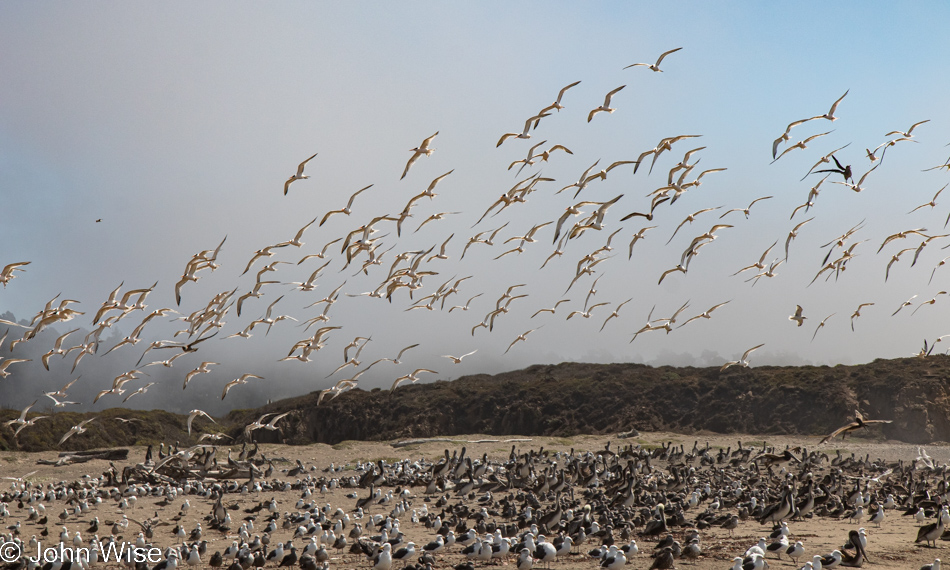
I’ve been mentioning Highway 1 and should point out that it’s also referred to as the Cabrillo Highway; maybe this will help the search engine algorithms note this post. We are just 5 miles up the road from our lunch and shopping stops and are already pulling over across from the San Simeon Creek Campground at the sight of Birdapalooza happening right there on the beach. All the shore birds were here, species from near and far just co-mingling like this festival was some kind of hippy hangout of a bunch of naked birds from Big Sur. (The people of Big Sur will know just what this references.)
It was at this point that the photographer on this expedition realized the extent of his own stupidity when, KNOWING we’d be having wildlife experiences, he left his 70-200mm lens in Phoenix, Arizona, where it wouldn’t be zooming in on pelicans, seals, or, potentially, whales. Why was it with us? That’s already been answered; I’m an idiot, that’s why.
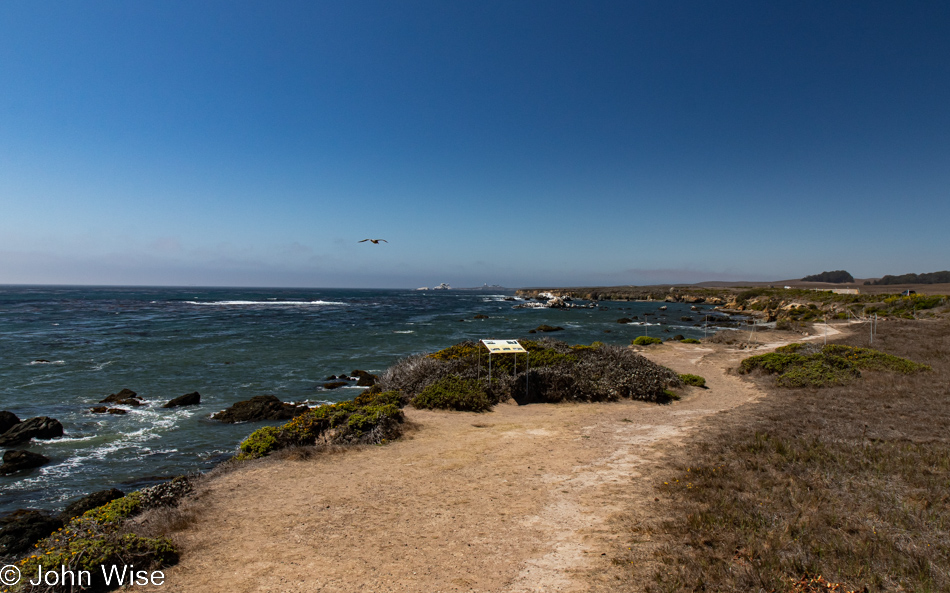
There’s a funny thought in my head when we aim for any coastal region, and that is we’ll be taking our time not to focus on photos, writing, or knitting but simply getting out in these gorgeous places to meander a bit. We’ll stroll the trail, walk the beach, hold hands, smile at one another, and gaze at all there is to take in on the preciously rare visits. Reality plays out differently from those naive expectations where idealized leisure should rule our day; we become anxious to see all and to see more. We want to discover that one corner, configuration of elements, or contrast of hues we’d never before witnessed. As though the sun bearing down was building an angle of repose using beauty in this construct created just for Caroline and me that would start cascading into an incomprehensible wash of such tremendous exquisiteness that our minds would be torn out of reality and cast into nirvana.
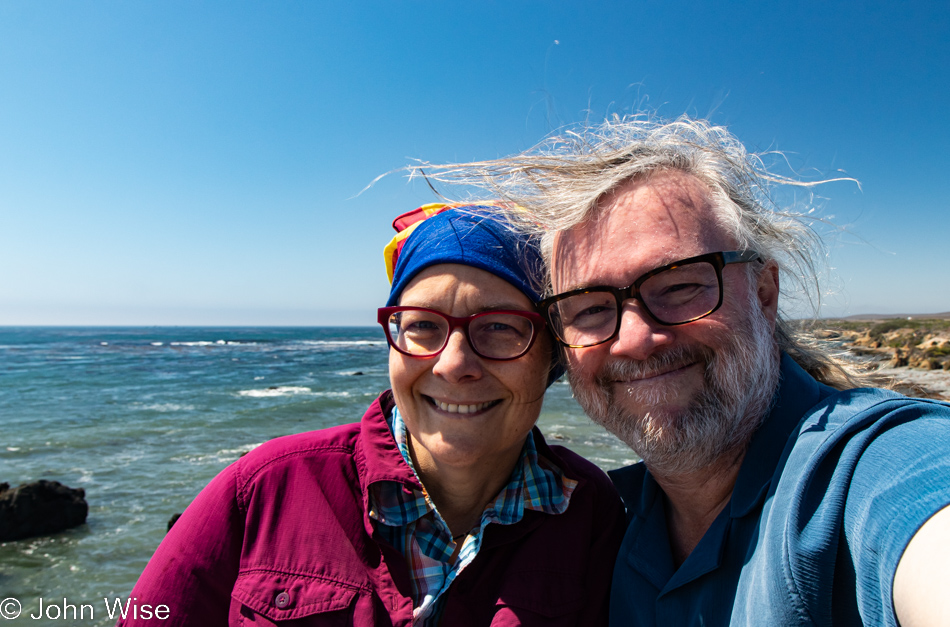
And this would be the appearance of my hair after returning from nirvana.
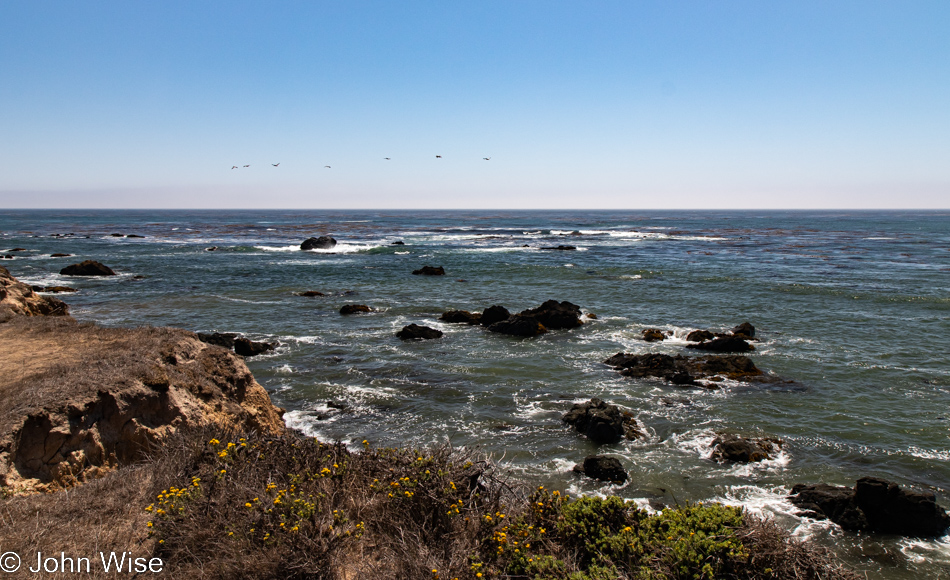
There are seven little dots left-of-center in the sky; they are pelicans. Has it been that we have rarely traveled the coast during late summer that we’ve not been so aware of their presence as we will be during this 5-day jaunt, or are they always here, and we are distracted by the other trillion details that clamor for our attention?
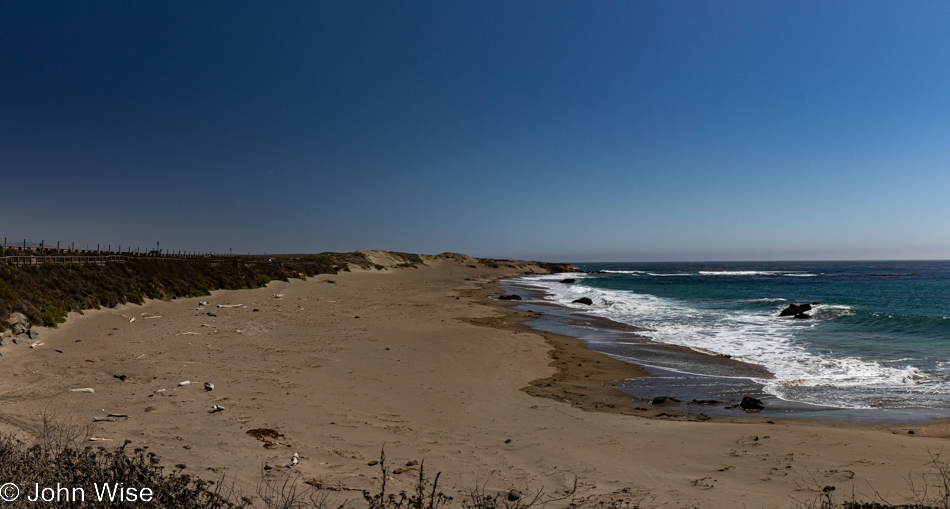
And then this! Now we know with certitude that this is the first time we’ve ever traveled this road in September. Why does an empty beach signify this? We are at the Elephant Seal Vista Point looking south; never before have we seen this sight without the presence of a colony spread far and wide across this protected stretch of beach.
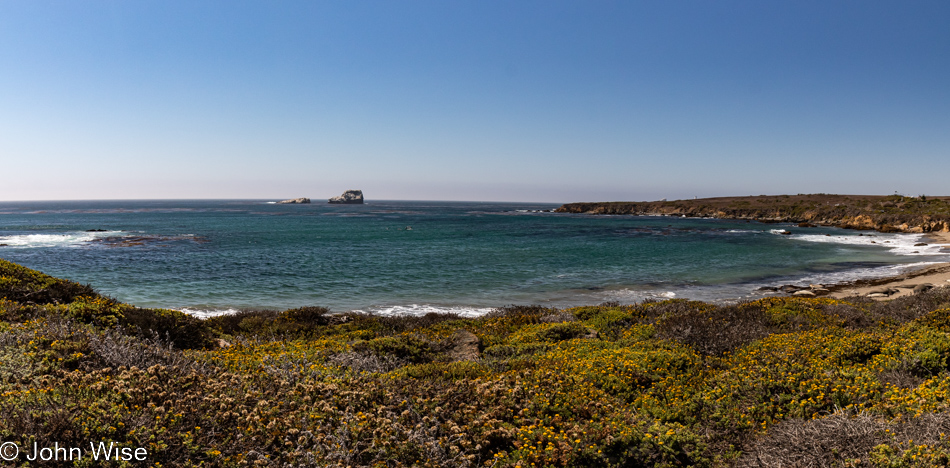
We are still at the Elephant Seal Vista Point now heeding the advice of a sign near the entry of the parking area that pointed to a northerly section of the beach and said, “Best Viewing.” This affords us the opportunity to share this seldom photographed section of the space between the two beaches the colony occupies.
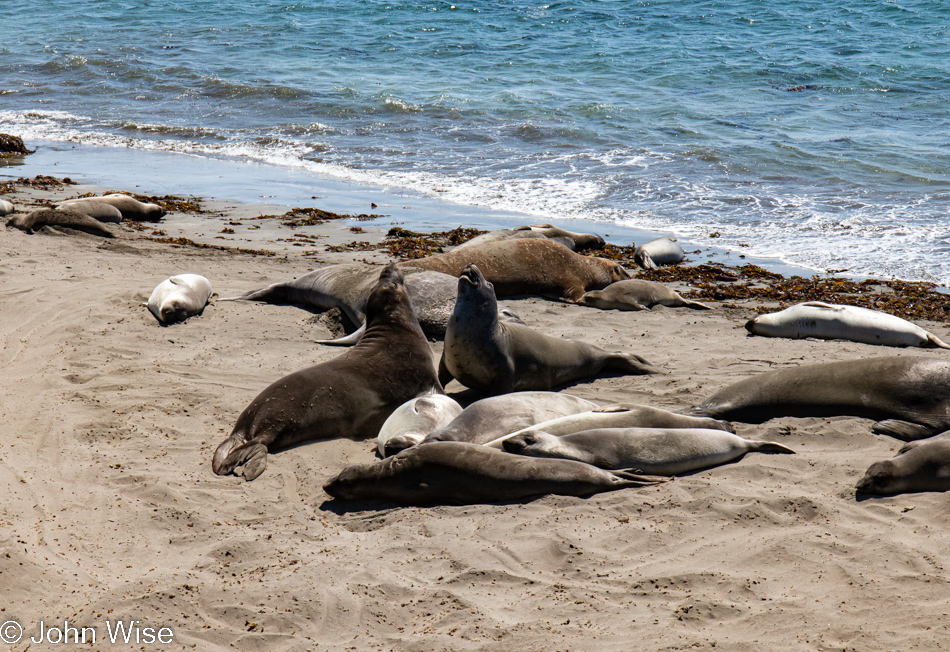
Sure enough, a small gathering of mostly adolescent seals was to be found over here. Thinking about it, I feel like I could have used any of the 100s of other images I’ve shot over the years to share here that would show a beach stuffed with these fat sea sausages lounging in the sun, tossing sand onto their baking sides, and grunting into position between other seals, vying for that perfect cozy spot that only an elephant seal can appreciate.
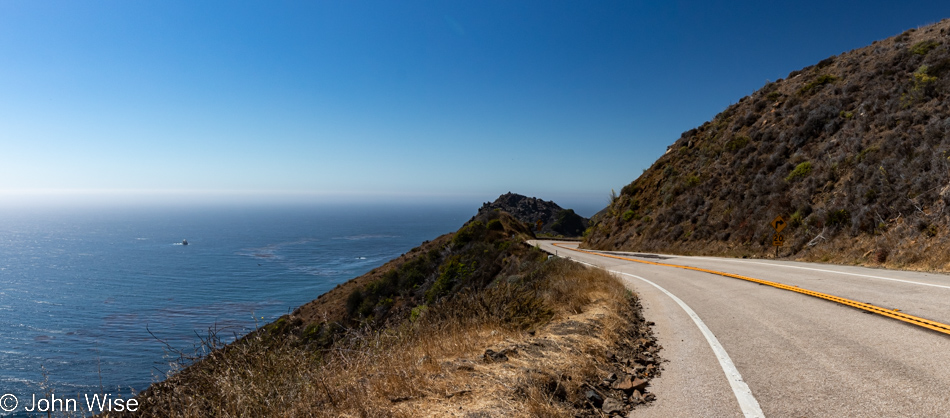
I just looked over to last year’s photo of the same location and saw that the sea was silver and that I was standing on the other side of the street. Part of me thinks that I should limit my efforts in writing this narrative by eliminating photos that are so similar to others I’ve posted, but then I might just remove every image included in this post and simply summarize our five days as “We visited the Big Sur coast again and went to the Monterey Bay Aquarium.”
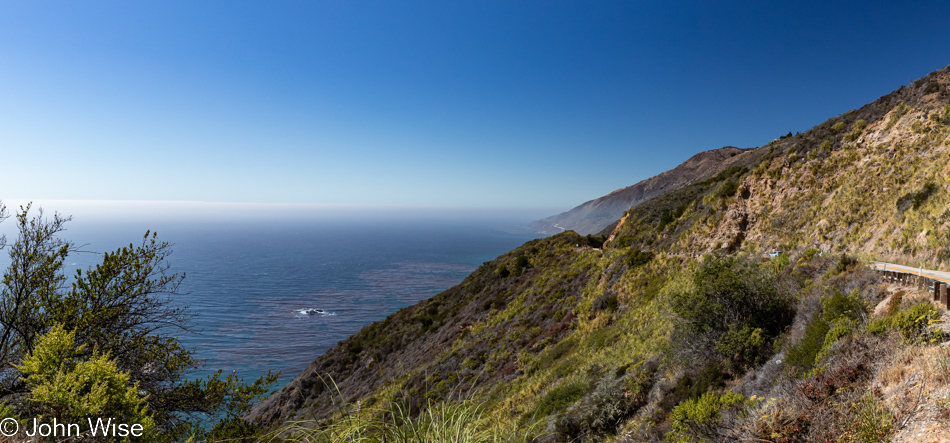
We are witnessing the hand of time representing the universe that has crafted this one moment where sea, sky, and earth painted in blues, greens, silvers, tans, and browns (and uncountable colors in between) come together to shape a view that only eternities are able to create. We might capture the scene and even attempt to put words to the pictures, but we stand before nature, stupid and illiterate in comparison, while the unseen fish to the left, the birds above, and the plants that cling to life live in harmony with their environment. It’s sad that we humans, with our ability to understand what we do wrong, seem incapable of correcting our mistakes.
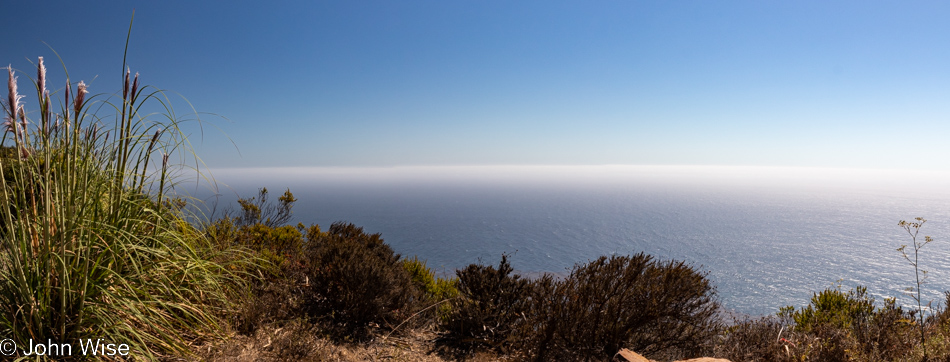
There is so much to smell, hear, and wonder about while standing at the edge of land. Everything else that isn’t here loses any importance. You are at a place that invites contemplation or nothing more than quiet appreciation. For a second, you are allowed to be a plant standing under the sun, oblivious to the trials and tribulations of a society that thrives on chaos, scarcity, fear, and uncertainty. If you are strong of character, you too might be able to find these places of turning away from the worst aspects of our inhumanity. Or maybe this type of solitude is too abrasive to the intensity you require to maintain the turmoil that propels you to keep racing down the highway of anger.
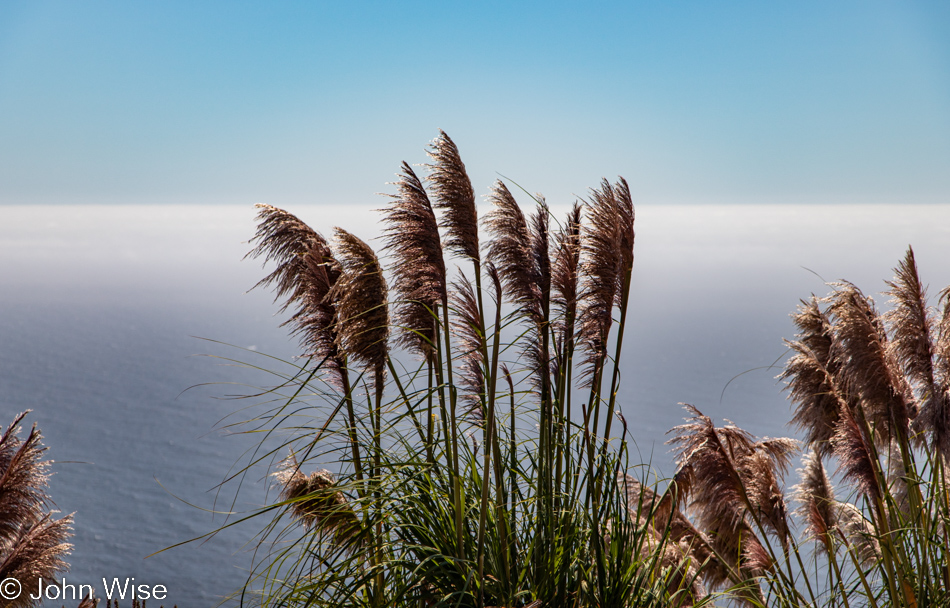
This pampas grass does not belong here; it is invasive. But it is beautiful as it captures the wind and offers a golden-red contrast to the blue sky and sea. Behind us are the mountains that make this coast so relatively difficult to visit, though we benefit from those who carved such a treacherous route here long before our arrival. Including the many pullouts along the road, we are allowed to crawl as slowly as we wish along this narrow trail hugging the coast, and from there, we step out of a car to stand before some of the greatest art nature has to offer, even if it’s out of place.
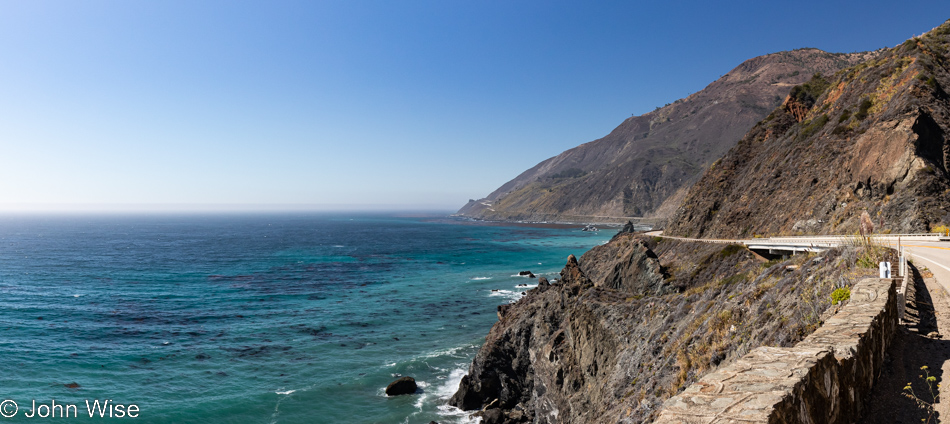
The color of the shallow waters begs us to know why we’ve ignored its glory for more than a year. How could we not return sooner to pay homage to such grandeur? Are the memories we carry with us over the past decades and many visits to this 100-mile stretch of America along the Pacific Ocean really so indelible that we can afford such distances between our returns? Absolutely not; we are failures for ignoring what burns so deeply in our imaginations, but time and money dictate that we are only allowed the share of life we can best afford; such is the equation of the present day.
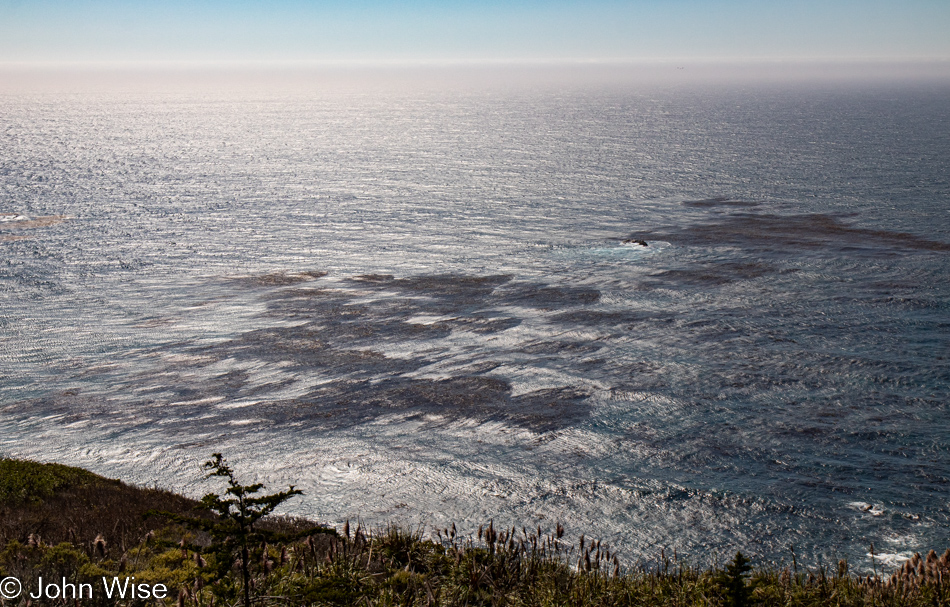
Wouldn’t you think that where there’s a kelp forest, it would stretch for miles? It seemingly does not, at least from the appearance of this one whose canopy reaches the surface of the glistening ocean. If I was a fish deep below, maybe I’d wonder what it was like to be those plants that touch the edge of space and almost intrude upon another dimension.
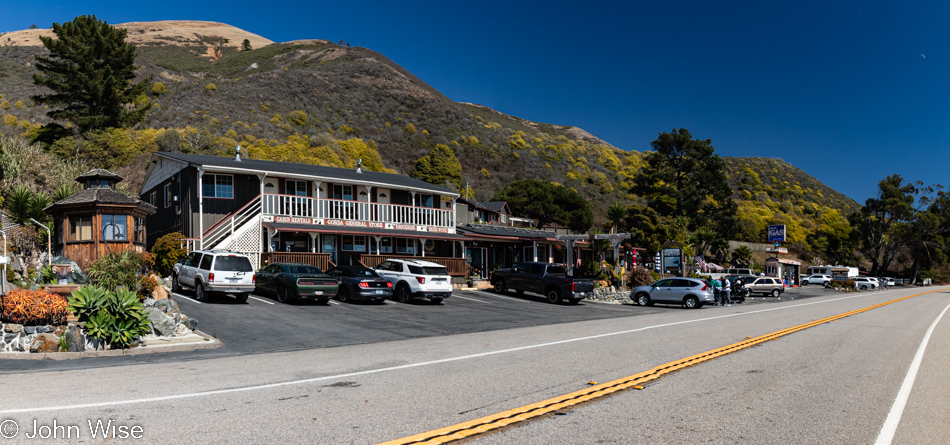
It’s taken us more than 3 hours to drive the 35 miles (56km) from Cambria to Gorda; I believe we might be driving too fast. Then again, here at 3:30 in the afternoon, we only have about 4 hours before the sun sets and then maybe 30 minutes of civil twilight before the night sky descends upon us. Of the night sky, we have had more than a few opportunities to enjoy the sight of it right here in this area as the Treebones Resort is just up the road a tiny bit, where from a Bird’s Nest high above the ocean we looked out in astonishment that we were the only two humans on the entirety of the earth who were doing just that.
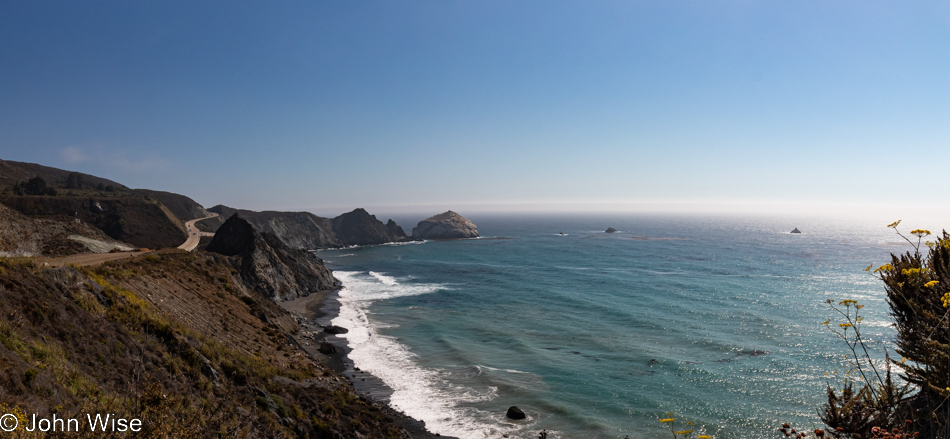
Once again, we stopped at the Seven Stairs pull-out. Last year there still was water flowing from a spring somewhere up the ravine. Today, it was dry as a bone, so instead, I present the view south from across the highway.
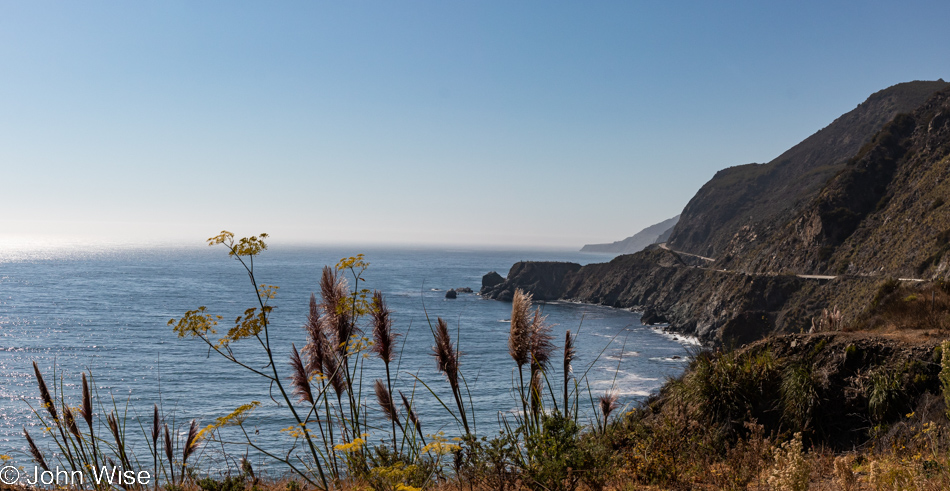
While I know this is not the view north from Seven Stairs, I’m not sure exactly where it is on the drive, and it really should stay that way because if we knew the exact layout of the coast, would it be so surprisingly new every time we are here?
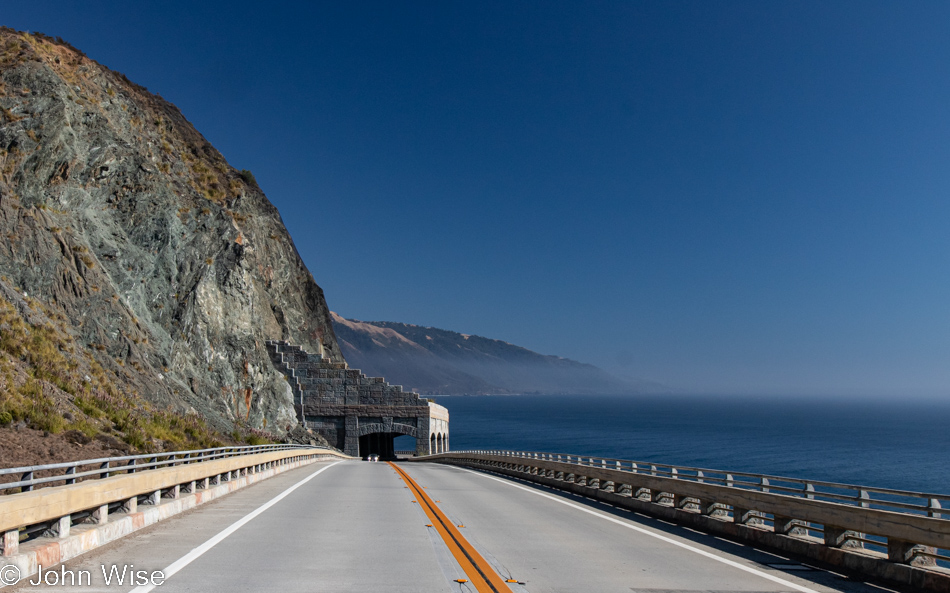
Rain Rocks Rock Shed & Pitkins Curve Bridge south of Lucia is relatively new to our visits. It was already built when we visited last year in 2021, but in the 6-year gap where we didn’t drive Highway 1, this was one of the sites prone to frequent rock falls.
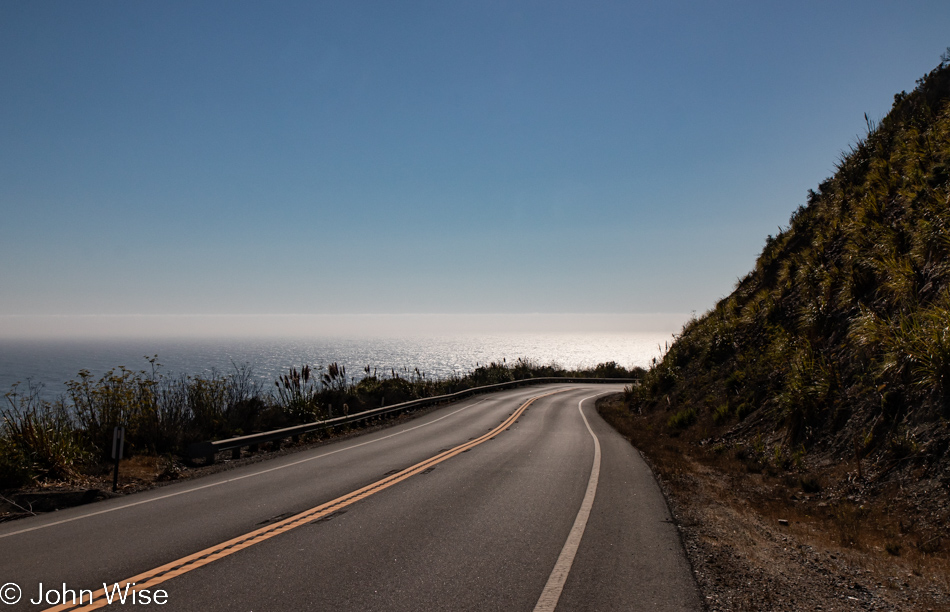
Writing of our 6-year gap in visits, we first visited the Pacific Coast together back in January 1991, and then after moving to the United States in 1995. It wasn’t until September 1996 and my mother-in-law Jutta’s first visit to the United States that we took her and ourselves up the coast. Old camera film without proper records betrays any idea of knowing much about dates or if even those old cameras were ever developed, so some trips out this way might be lost in the fog of time, but after a quick scouring of the blog posts, I have made I can share the following.
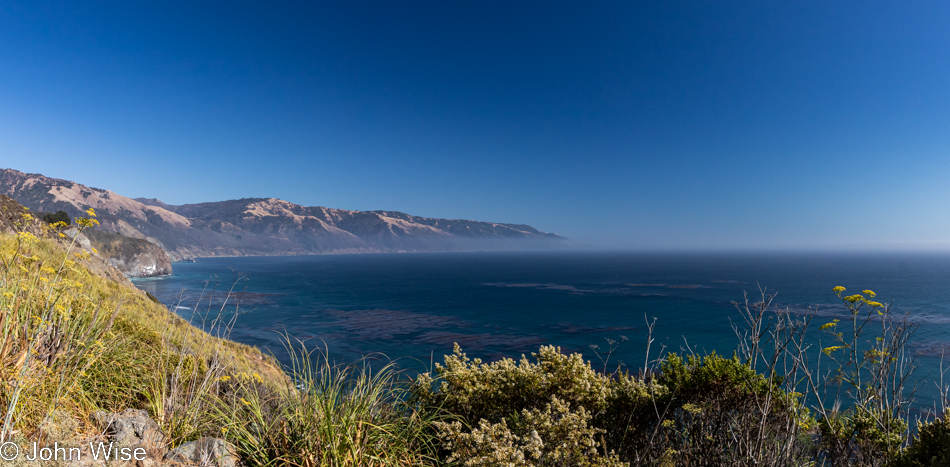
We visited all or some significant part of this section of the coast on these dates: October 2001, November 2001, January 2002, April 2002, May 2002, January 2004, October 2004, February 2005, May 2005, November 2005, December 2005, November 2006, January 2011, November 2011, December 2017, May 2021, and now again in September 2022. I linked those previous trips to the months they occurred.
Up until this moment of writing this post, I had no real idea of how many times Caroline and I have been so fortunate to visit the central California coast, but our photos say it’s no less than 19 times. Sure, if you live in the San Francisco area or Santa Barbara to San Luis Obispo, or even to the east over the coastal range, visiting the Cabrillo Highway (a.k.a. Highway 1, a.k.a. PCH) along the Pacific Ocean might be the most natural thing to do regularly, but we are just two normal schmoes living in a desert 650 miles (1,000km) away.
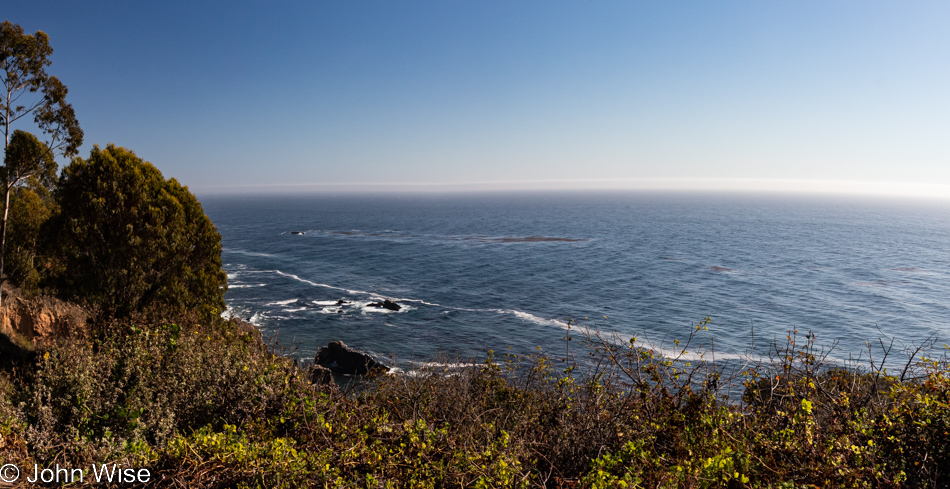
Good thing we didn’t wait for Lucia as the restaurant and gift store were mostly destroyed in a fire that shut it down last year; it’s in the process of being rebuilt, we hope.
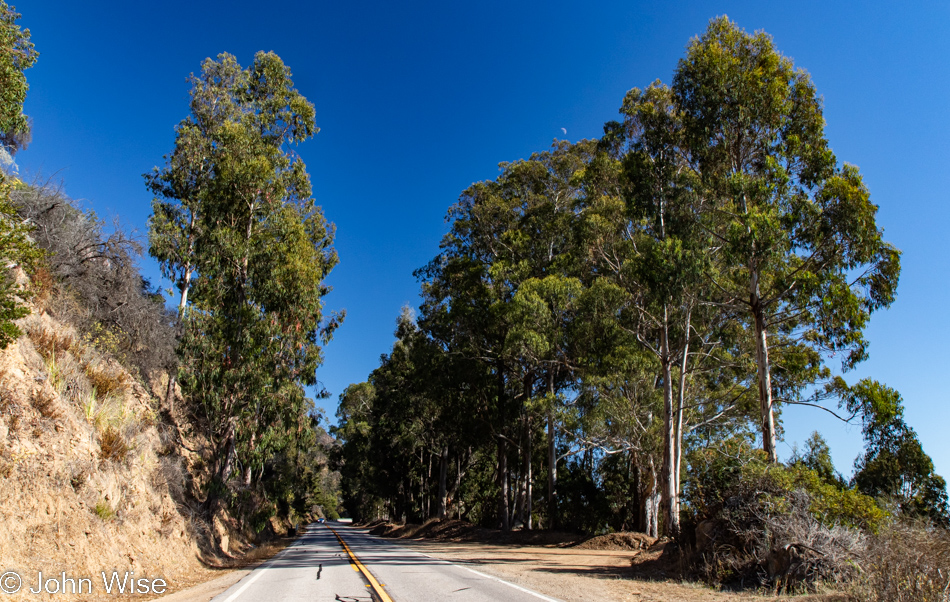
The dominant smell on the coast might be sea air, but it’s the eucalyptus that excites squeals of delight from us when we catch its fragrance as we continually pass through. Every visit to the central coast we’ve ever made it is the eucalyptus we dream of and will forever associate with this part of California. Jumping ahead in the afternoon, Caroline and I couldn’t find a sign of our favorite eucalyptus bar soap we first bought out here, nor did we have luck last year, so we started thinking that Big Sur Country Soap company might have ceased operations because last year we were unable to locate any either. Well, looking at this photo of the eucalyptus trees, I checked to see if there was still a web presence, and while the site was down, Bing search supplied me with a phone number to the company. Sheila, the founder of Big Sur Country Soap answered and assured me things are still going forward and will be sending out an order for me shortly.
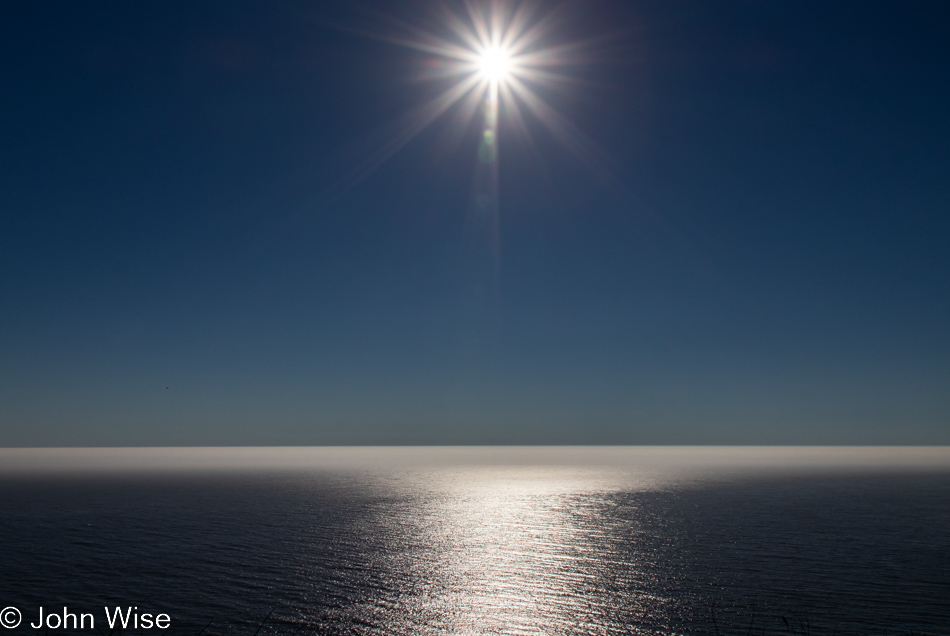
At least on this day and countless others, actually, we have experienced untold perfection, and through my feeble attempts at conveying a hint of this with my writing and photographs, I can’t imagine anyone could gather a hint of just how exceptional our shared time has been. The little things like the scent of eucalyptus, a cloudless sky or one dotted with puffballs, the reflection of the sun in a blindingly bright strip of silver, a random butterfly, a barking seal, or a slight breeze that weaves all of these things together to bring them to us personally as we arrive at the right moment to experience it all in a way that no one has ever shared with someone else before. This is all ours because we bring ourselves into these places full of love and little expectation other than we’re certain that no matter the conditions, it will all be perfect for us.
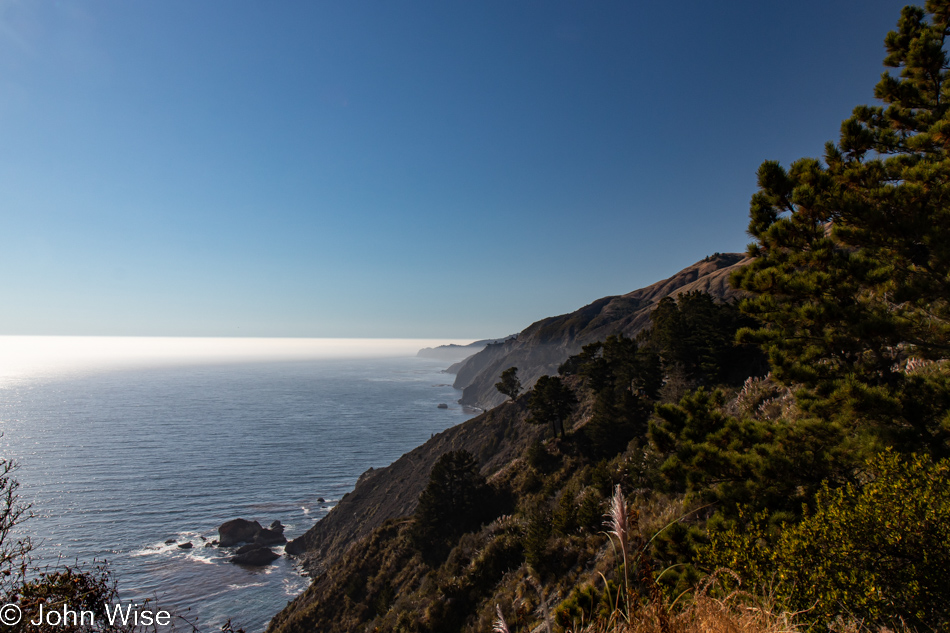
If you look back on our many excursions up and down this wild coast, you’ll notice two things: rarely will you ever see others, and you might note that we’ve never visited Hearst Castle. You could have the impression that we are alone out here; well, that’s intentional for our memories as I make an effort to snap an image when no one else is in the frame. This way, I’ve captured how we see ourselves out in this landscape, just us and all the things that are most important. Regarding Hearst Castle, both of us have been to European castles and not even Versailles outside of Paris ($22) or Schönbrunn Palace in Vienna ($26), charge anywhere close to the almost $100 per person it costs to visit Hearst Castle.
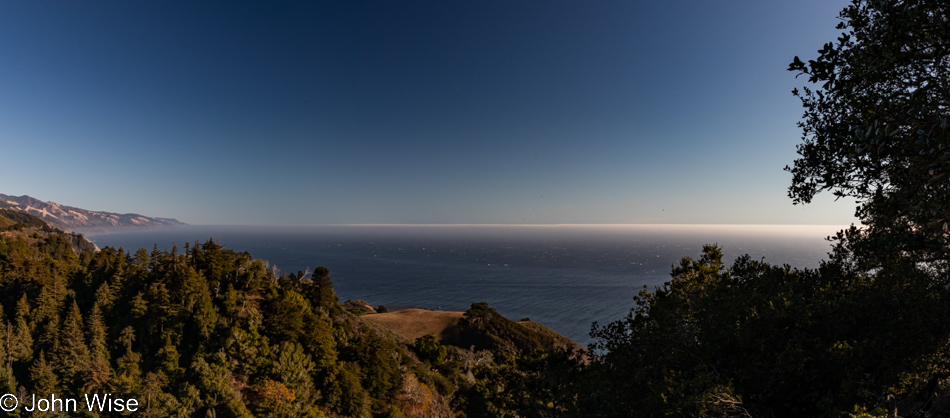
We are at the only slightly lesser great view from below the famous Nepenthe Restaurant here in Big Sur, at the Phoenix Gift Store. After trying the restaurant one time many years ago and receiving rushed service for the food we found mediocre, we’ve never given it a second nod, not that we haven’t considered it if only for the view but the outpouring of elitism from the customers and some of the staff left a permanently poor impression. In my view, a picnic along the coast anywhere else, lunch in Cambria, or waiting until you reach Carmel or Monterey would be the better choice unless you need bragging rights and self-congratulatory selfies that show you’ve been to Nepenthe, the Icon.
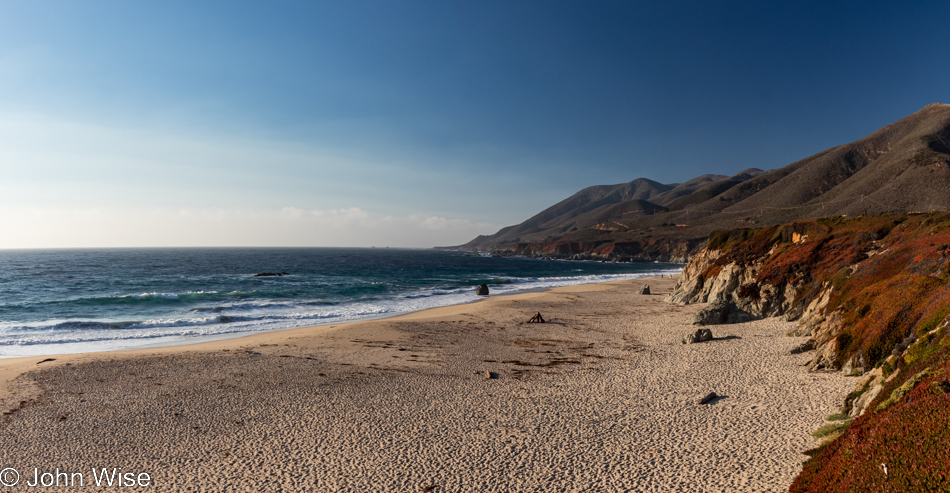
Garrapata Beach cannot be passed by, however. We must stop, although I was a bit worried due to Caroline’s healing foot that was just operated on 29 days earlier. But here we are, about to finish the last dozen or so steps before reaching the beach.
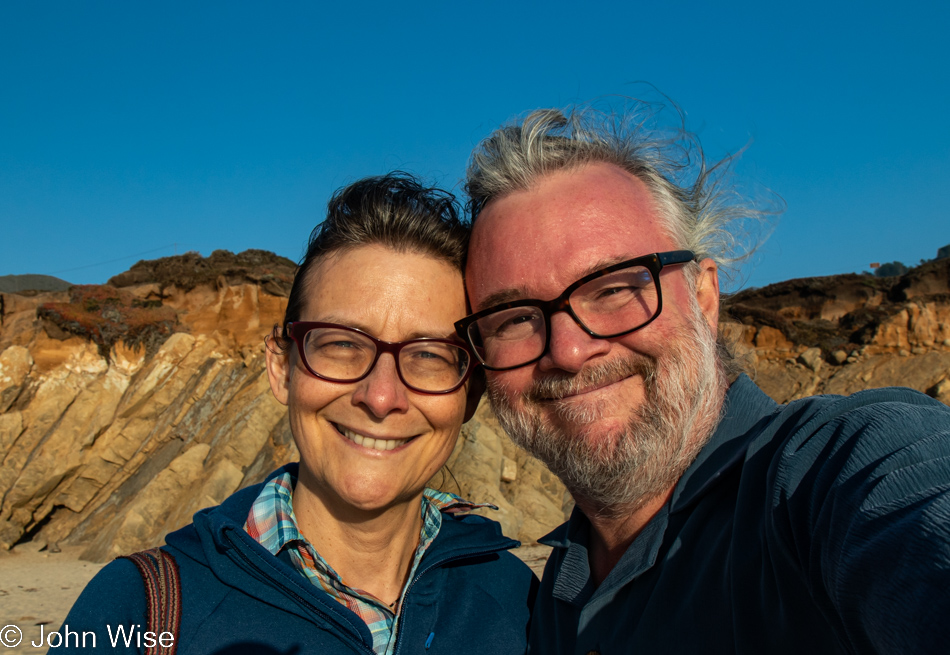
Considering that I pointed out our previous 18 visits to the coast, one could figure that I’ve shared this at least half a dozen times before, but I’ll state it again: this is one of our all-time favorite beaches. In the early years of our visits, there were never any other cars at the unmarked pull-out, and you could barely see the trail, but in the distance, you could just make out the partly broken stairs leading to the beach. We’d walk out to the loudest waves we’d ever heard as the sound bounced off the cliffs you see behind us in this photo. Not only that, they approach the shore out of the depths and quickly crash and retract with a respectable amount of obvious violence that warns you to be aware of these waters. Never have we seen someone in the surf here; nobody surfs Garrapata.
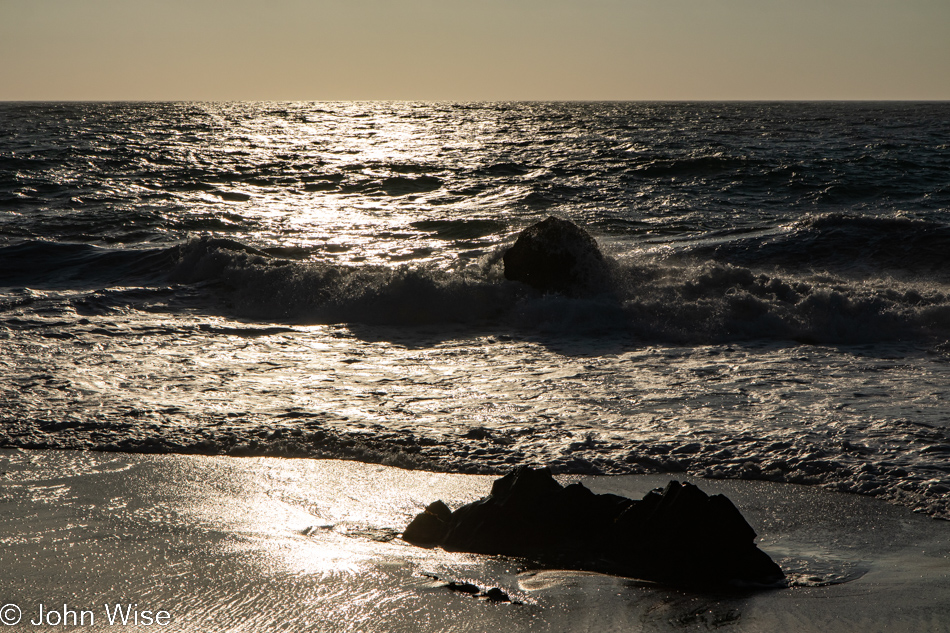
But here, on a late summer day, things seem pretty calm, relatively.
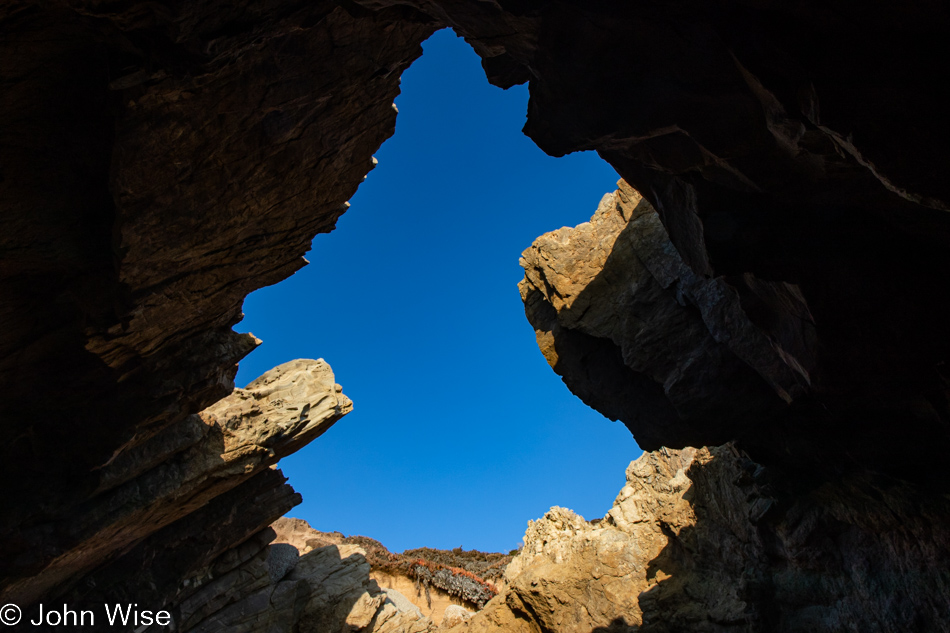
This is something new to us that we’ve never seen before, and maybe for good reason. It’s a kind of cave, or maybe it’s more appropriately called a blowhole, created where the surf rushes in to carve out the underlying rock, leaving this opening in its ceiling. Looking for a better description, I came across only one mention of this “blowhole” at Garrapata in a news story that showed helicopter footage of deadly surf rushing into this space from “14-foot waves spaced 9 seconds apart” while they were trying to rescue an 18-year-old who fell in from above and disappeared into the whitewater. Yikes.
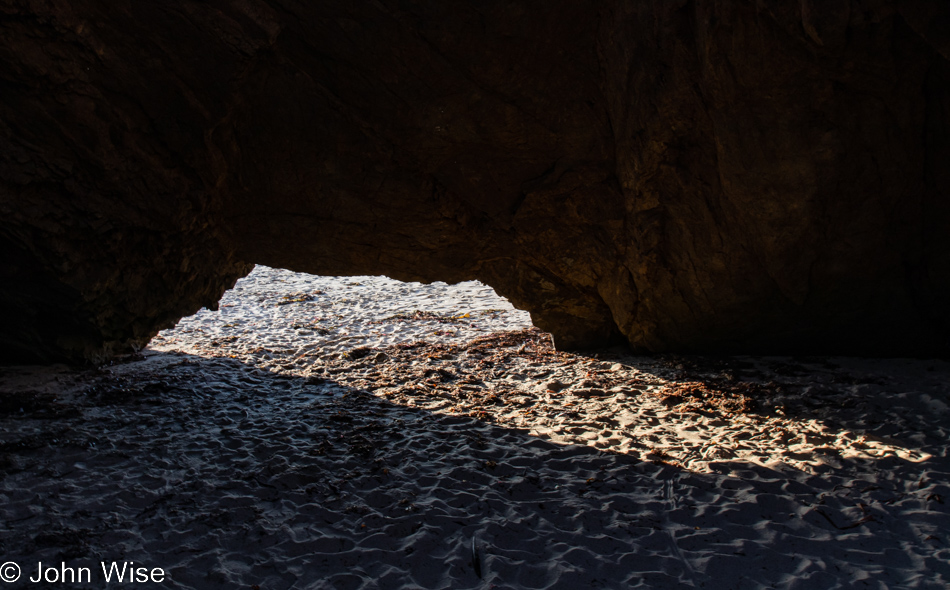
I said there was a good reason we’ve not been in here: the shoreline at Garrapata is always being reshaped by the surf, and on this day, just as we were turning around from the south end of the beach I noticed this small opening that looked at first glance like a ledge, but it was the appearance of light beyond the opening that looked inexplicable. At first, I thought to just let it go, and we walked on but then considered that the next time we were here, that opening might be hidden by the shifting sands. So, we did what all knuckleheads would do: we crawled in and hoped there wouldn’t be some rogue wave crashing in through that narrow slot. It’s a good thing we knew nothing about the kid who died here back in 2019, as we would have never entered this place. All the same, it appears that we might now have posted the first photos from within the Garrapata blowhole.
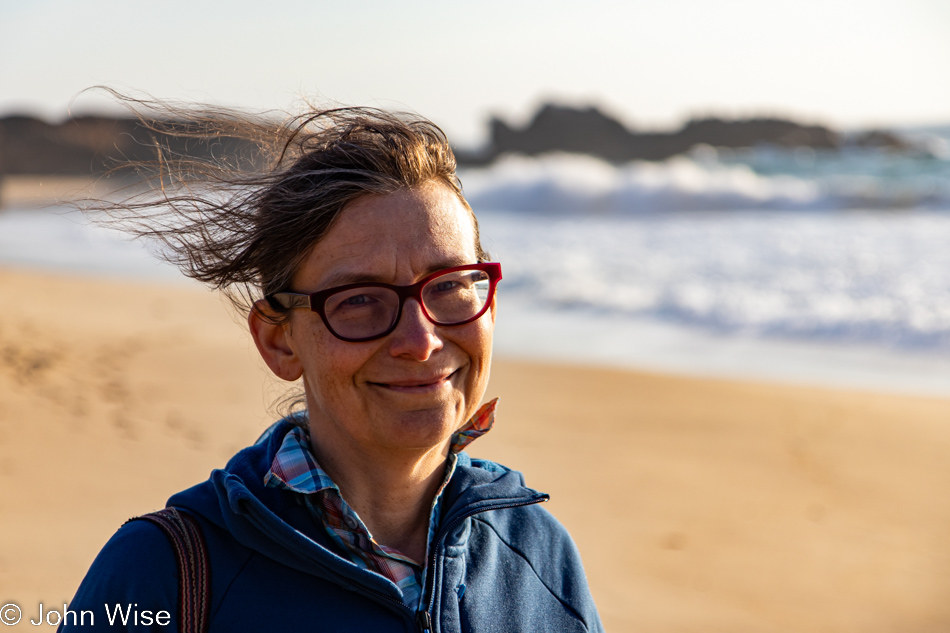
There are songs that tell the story about these being the days of our lives, and they don’t lie; these are those days.
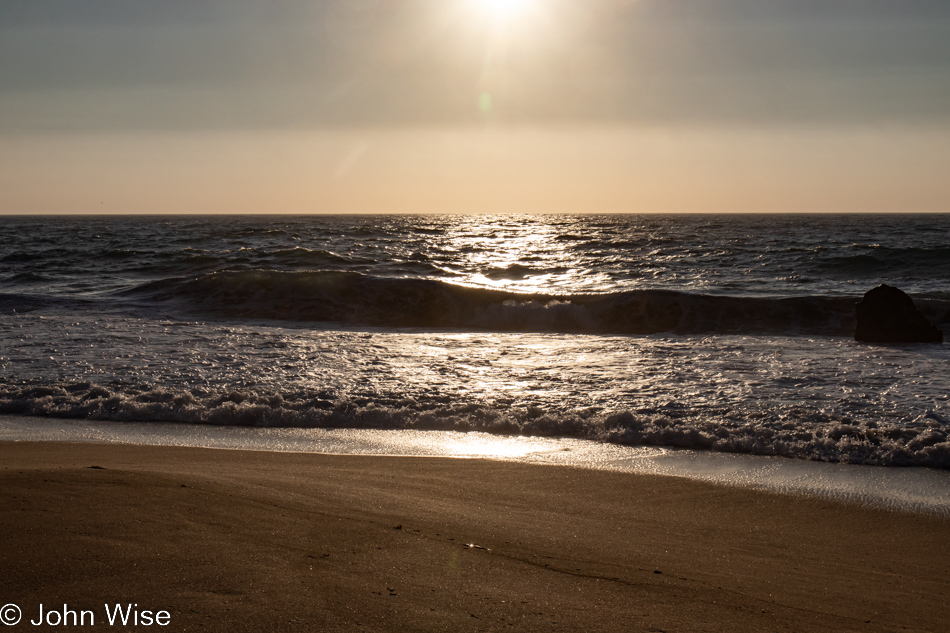
This drive has been one of the most stress-free journeys up or down the coast we’ve yet experienced. I attribute this to the fact that I’d decided to go as slow as I pleased, to not curse those crawling up our backside, and to pull over as soon as I saw anyone far behind that was likely going to rapidly close the gap. I don’t know if this strategy impacted the amount of time we spent on the coast, but I can share that we averaged just under 14mph for the 104 miles between Cambria and Pacific Grove. Of course, there were probably between 30 and 40 stops along the way that contributed to our speed of slow.
It was after sunset when we checked into Borg’s Motel at Lover’s Point in Pacific Grove, and we missed the moment the sun sunk below the horizon while driving through the forested area east of Carmel, but who cares, considering all that we’ve seen and experienced on this glorious day.
For dinner, we headed up the road into Monterey for a visit to the Wonju Korean restaurant, where we ate a couple of times last year. It was the same lady working everything by herself as during our previous visits and again, for being in a tourist town, it’s a good meal.
But now it’s 9:00, and we have to drag ourselves back to the Borg as we have to rise with tomorrow’s sunrise to keep the magic of vacation vibrating at the right frequency, that being perfection.
